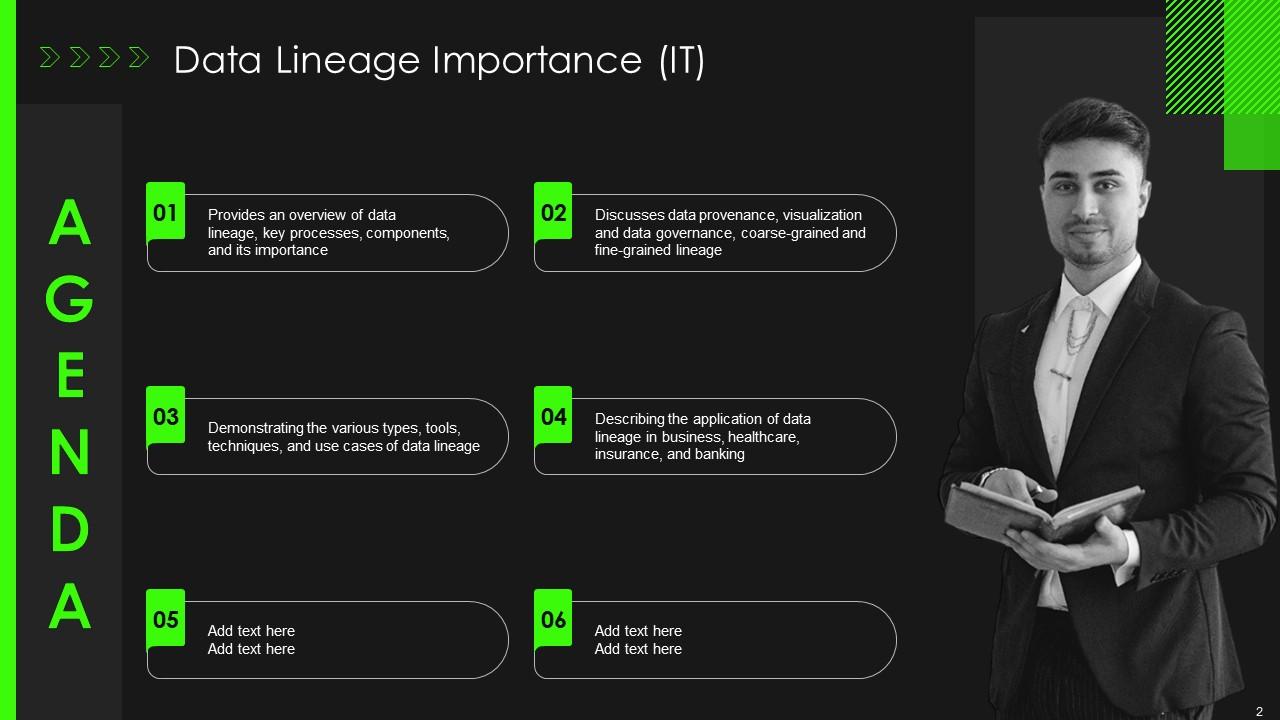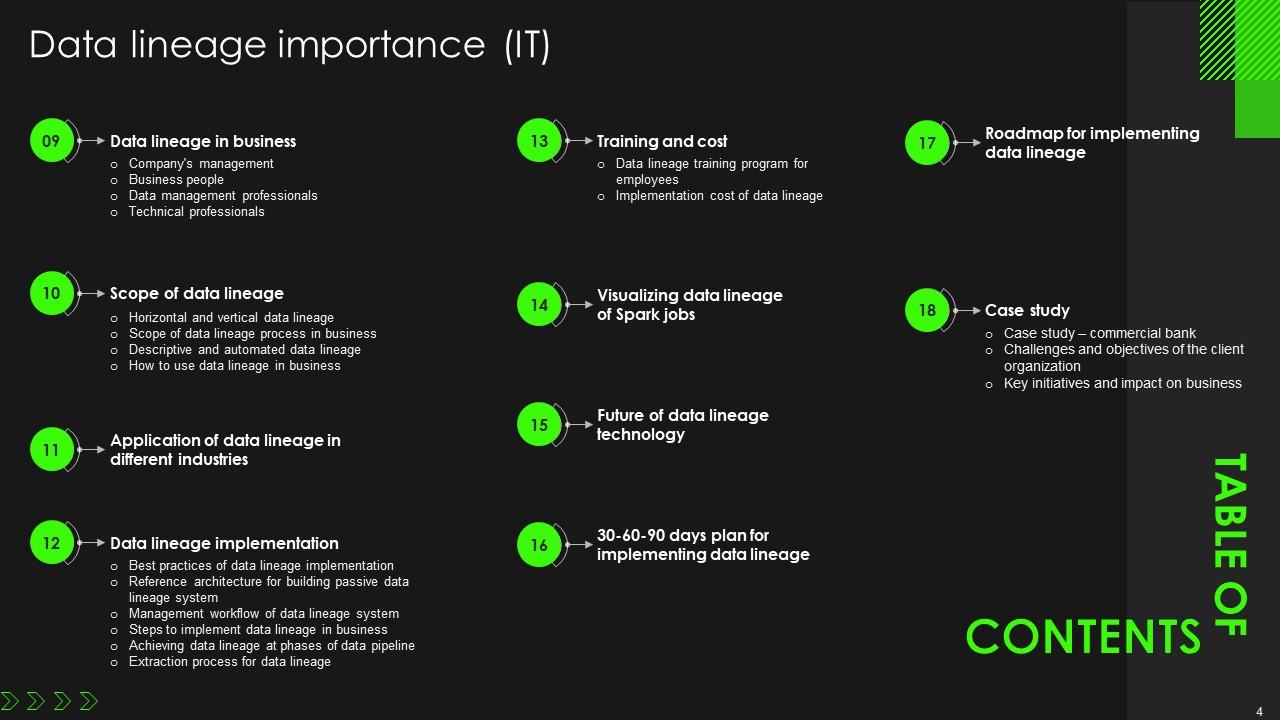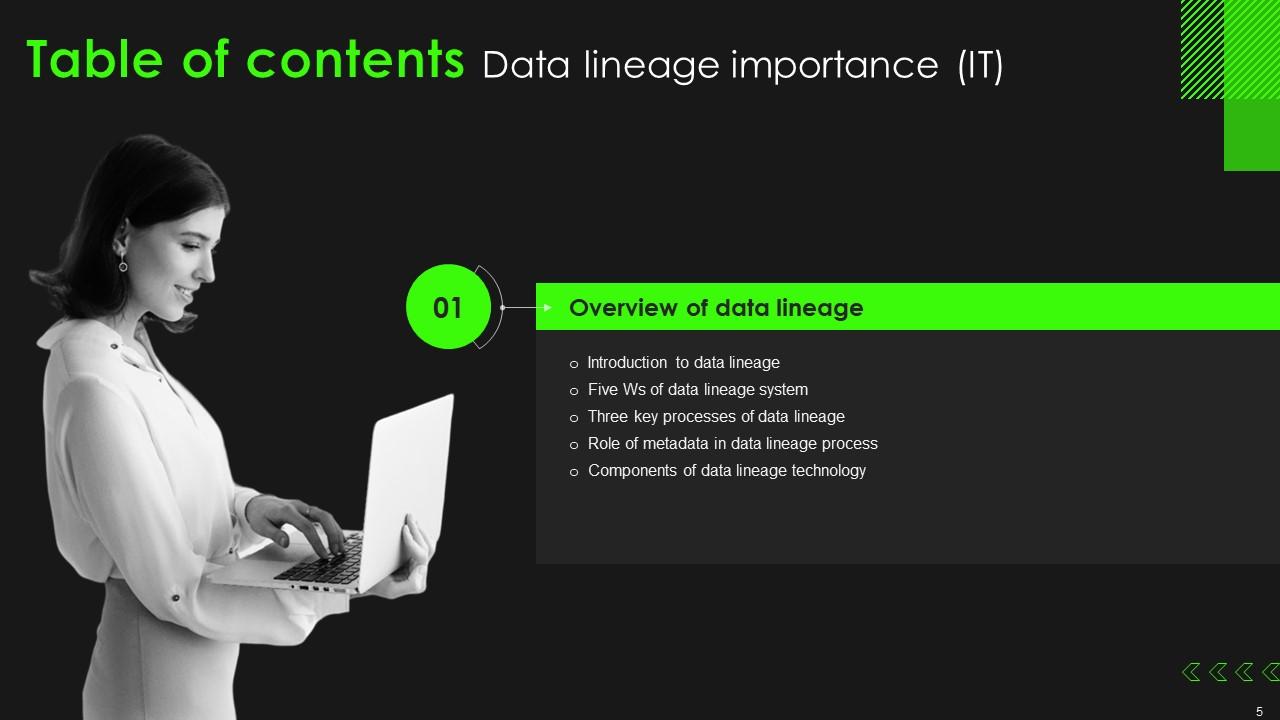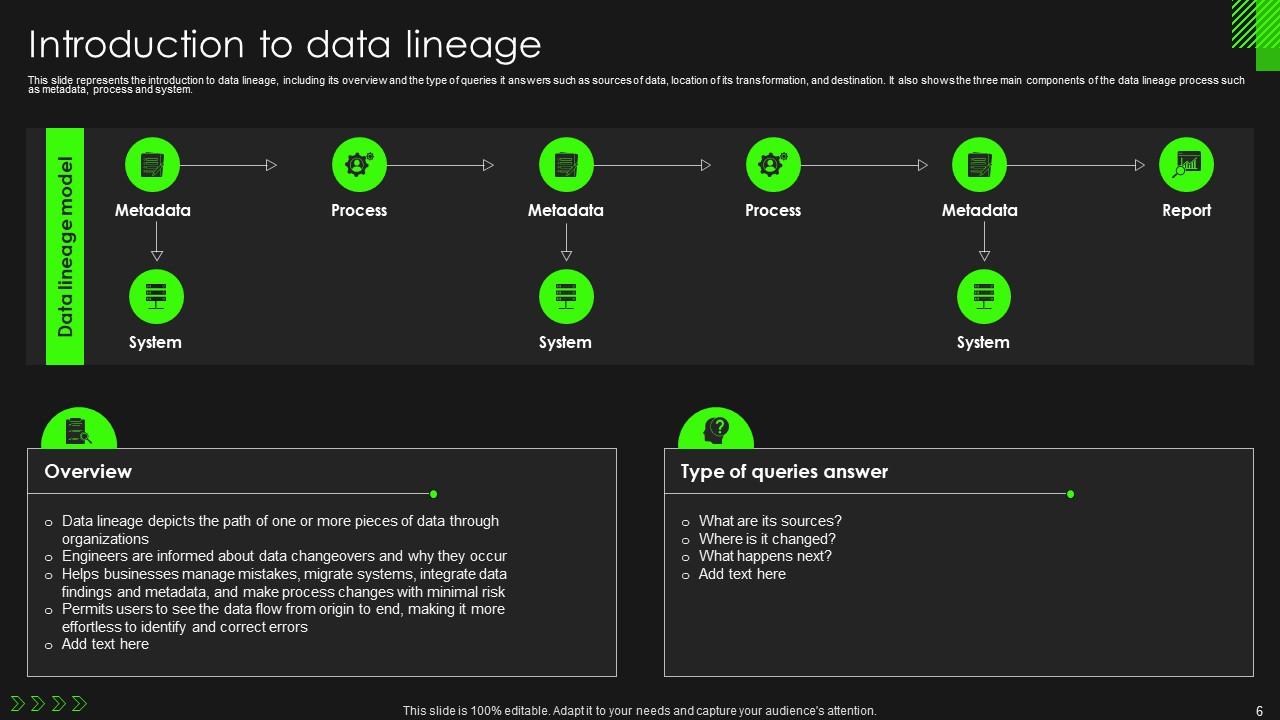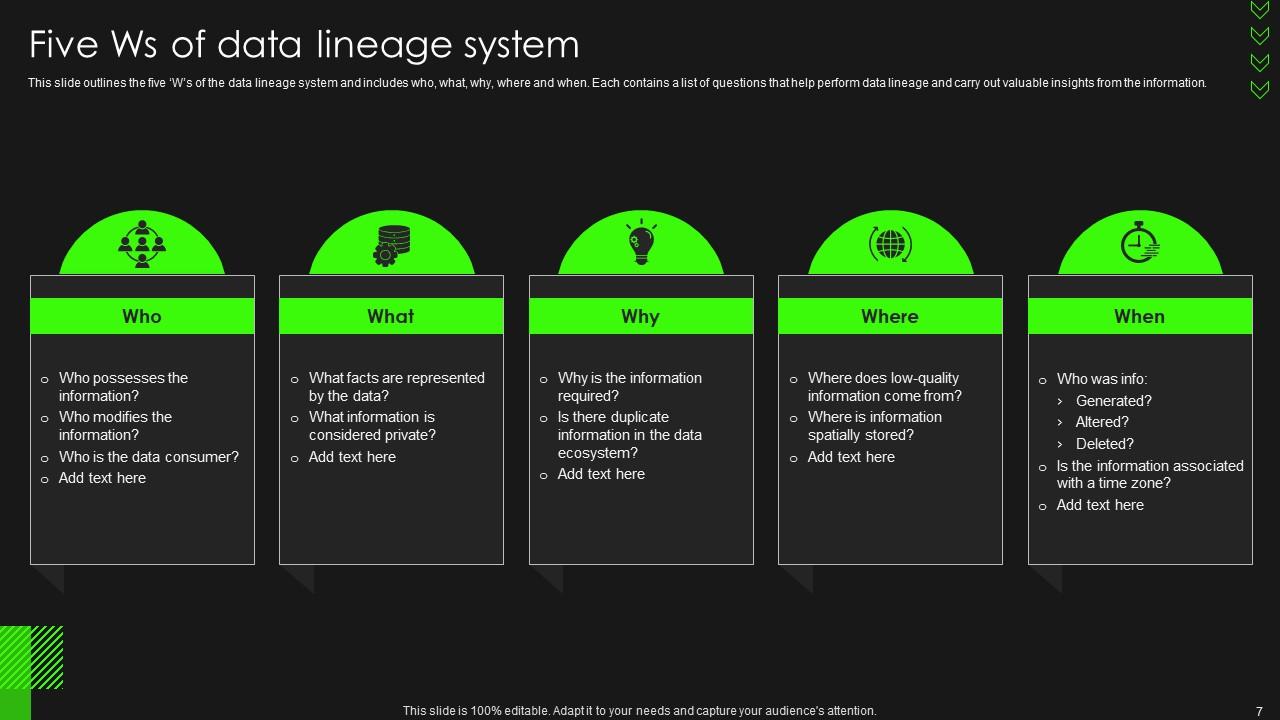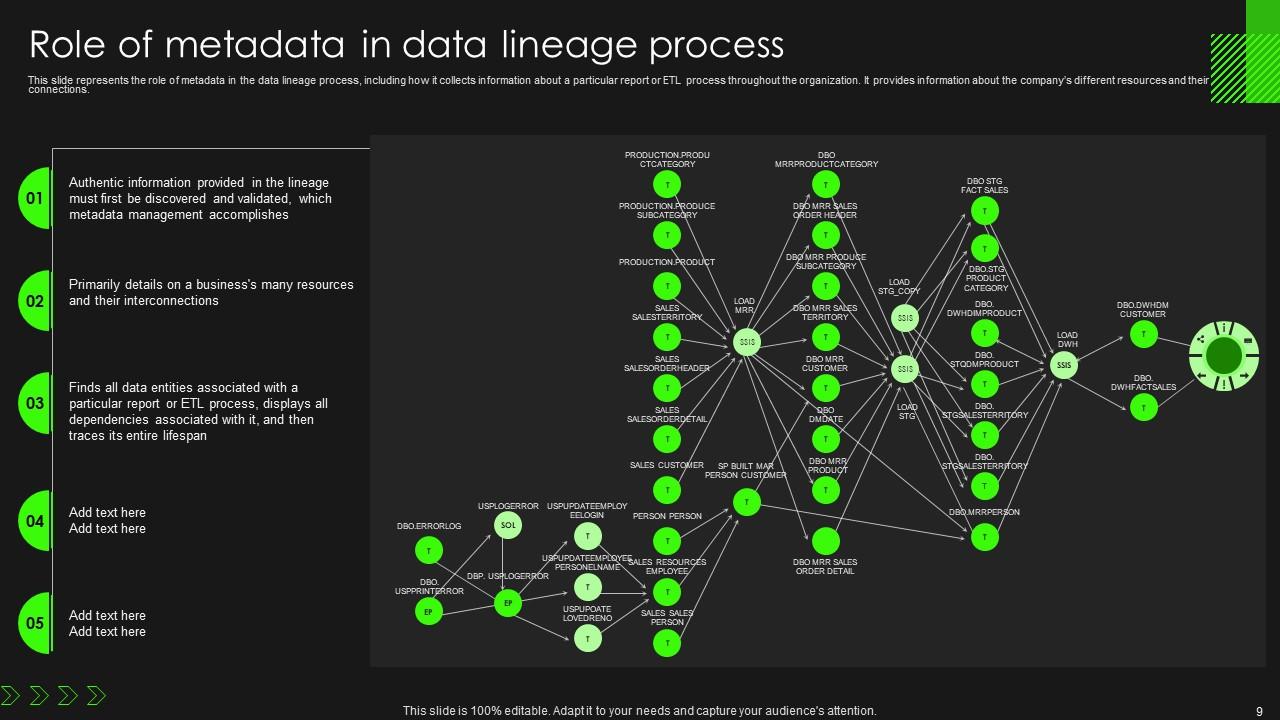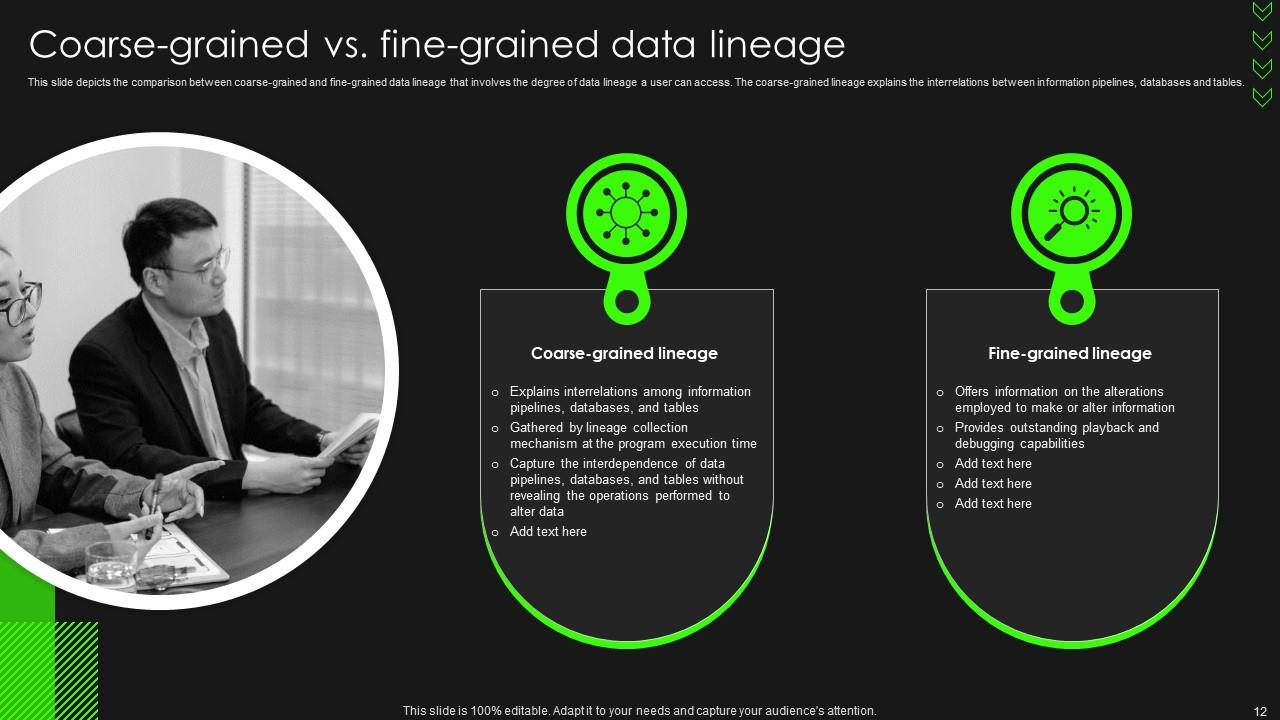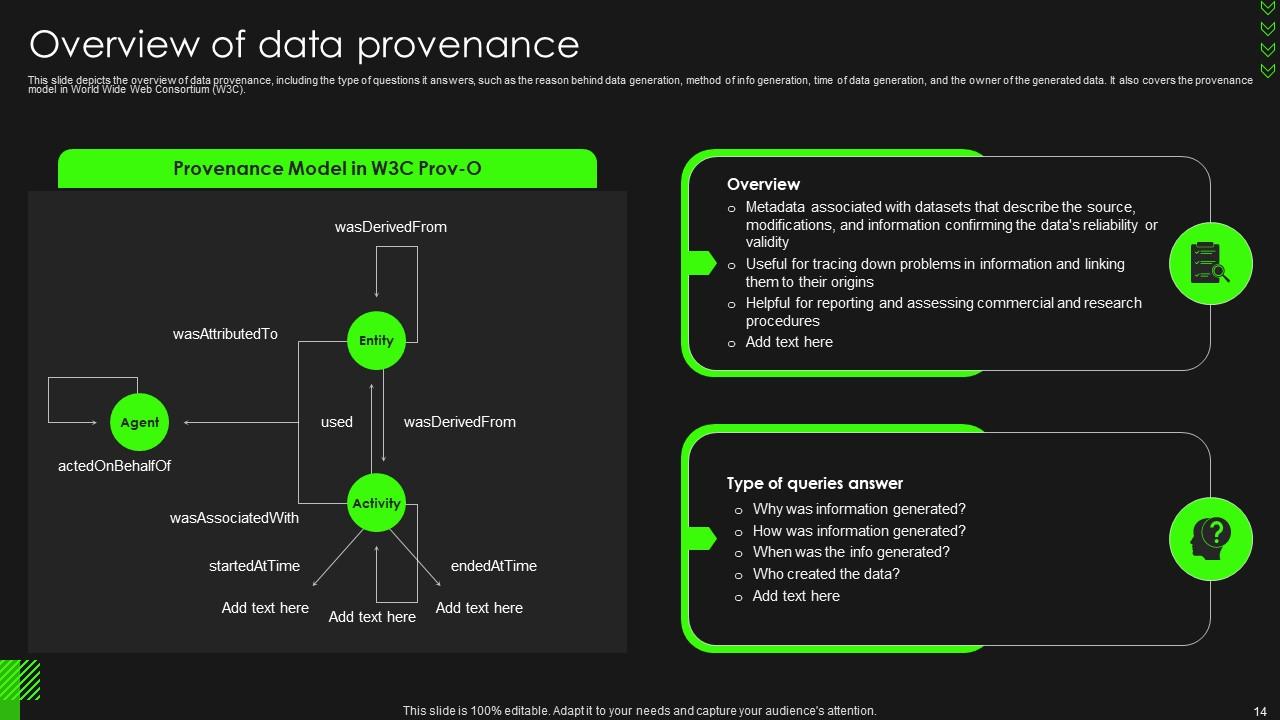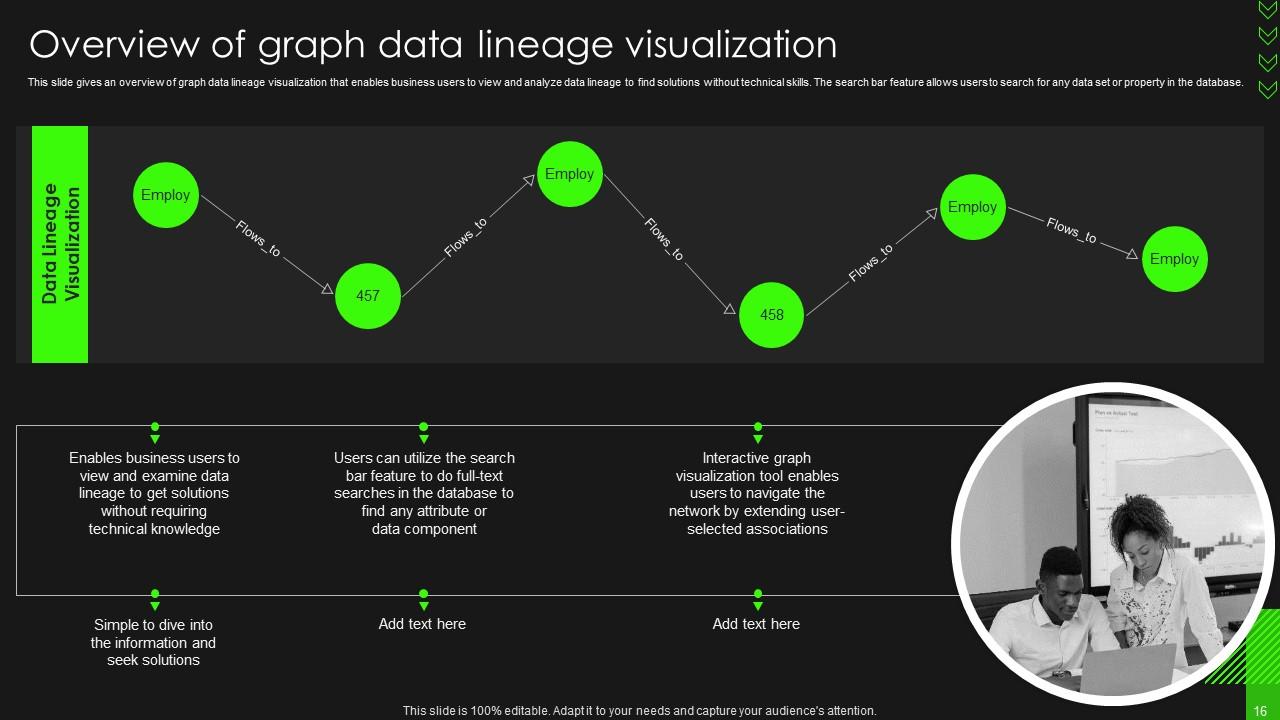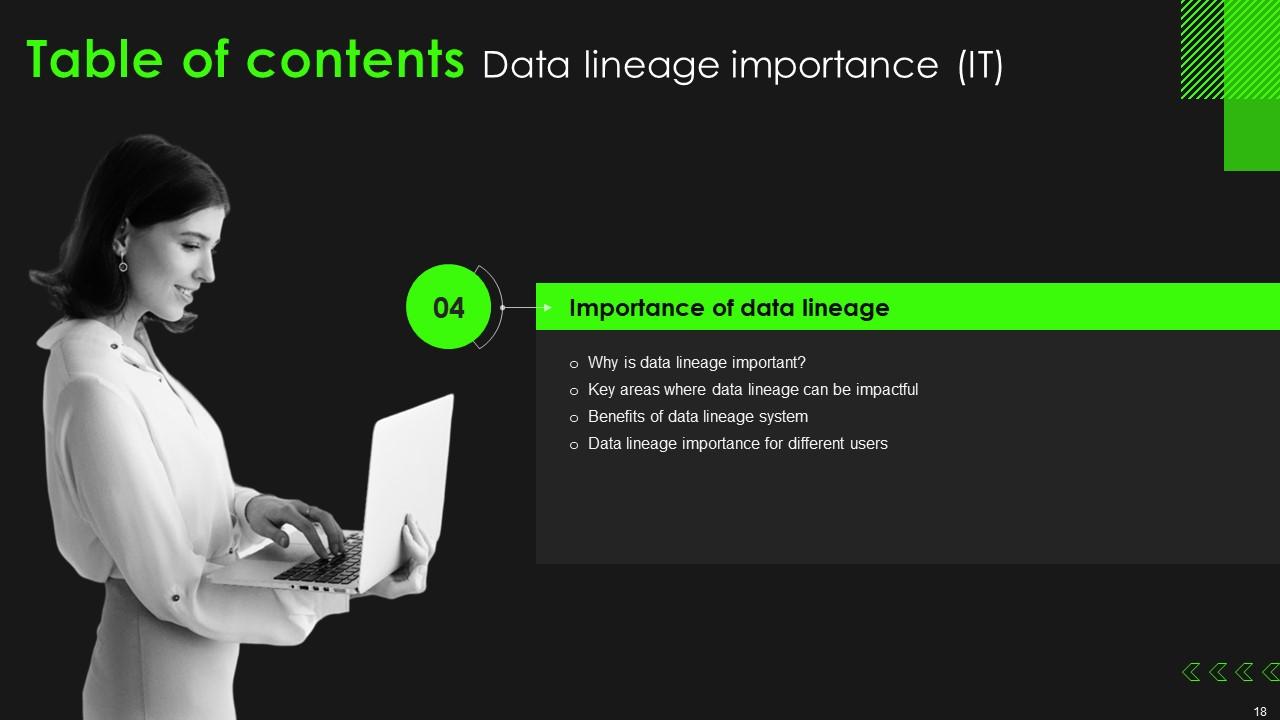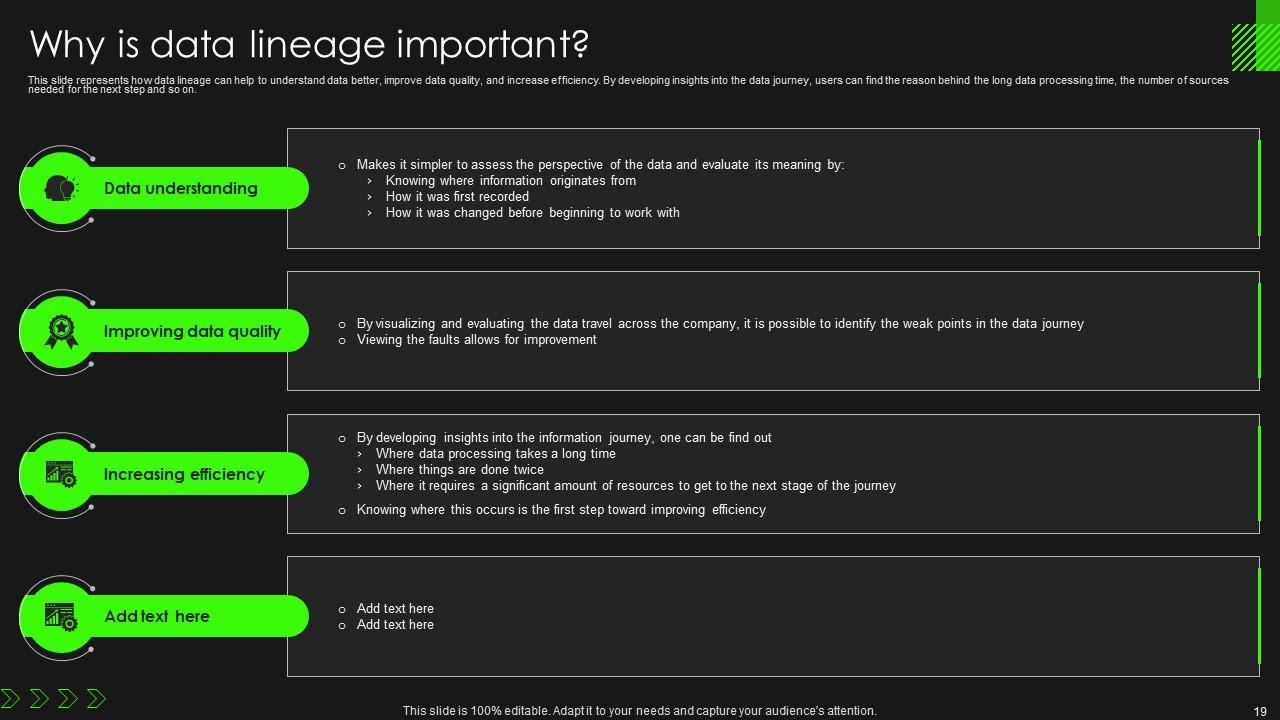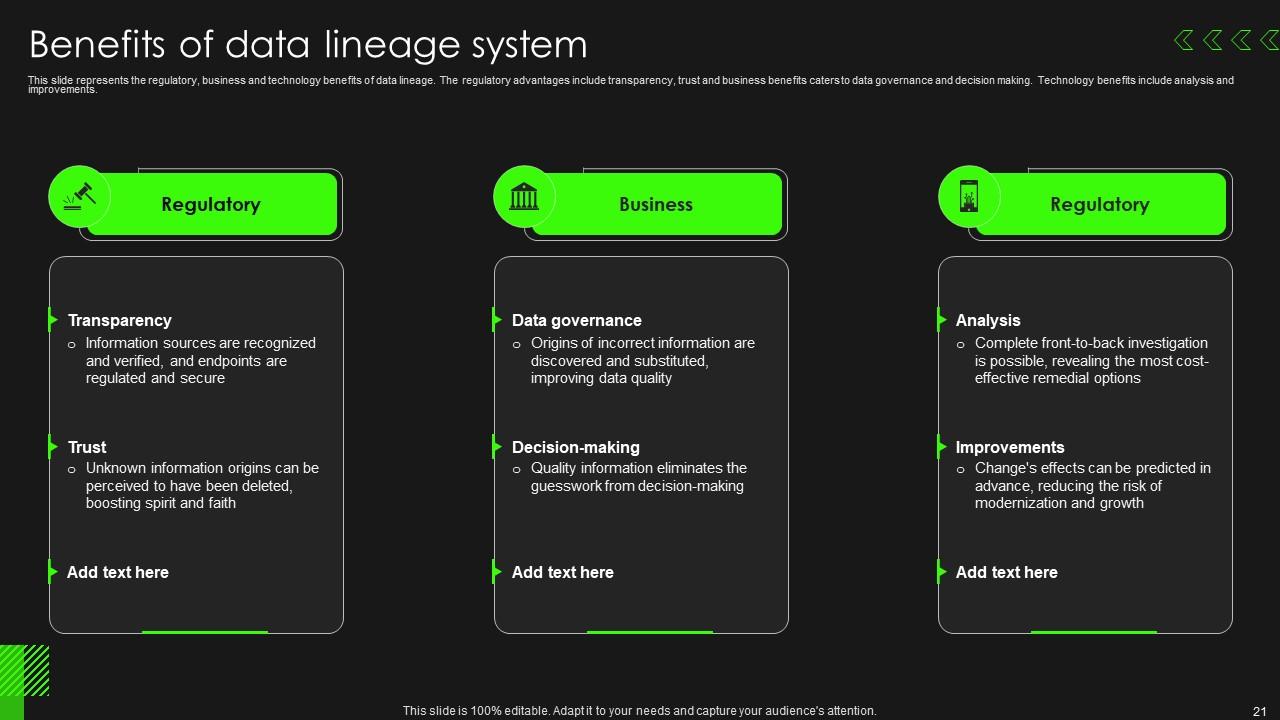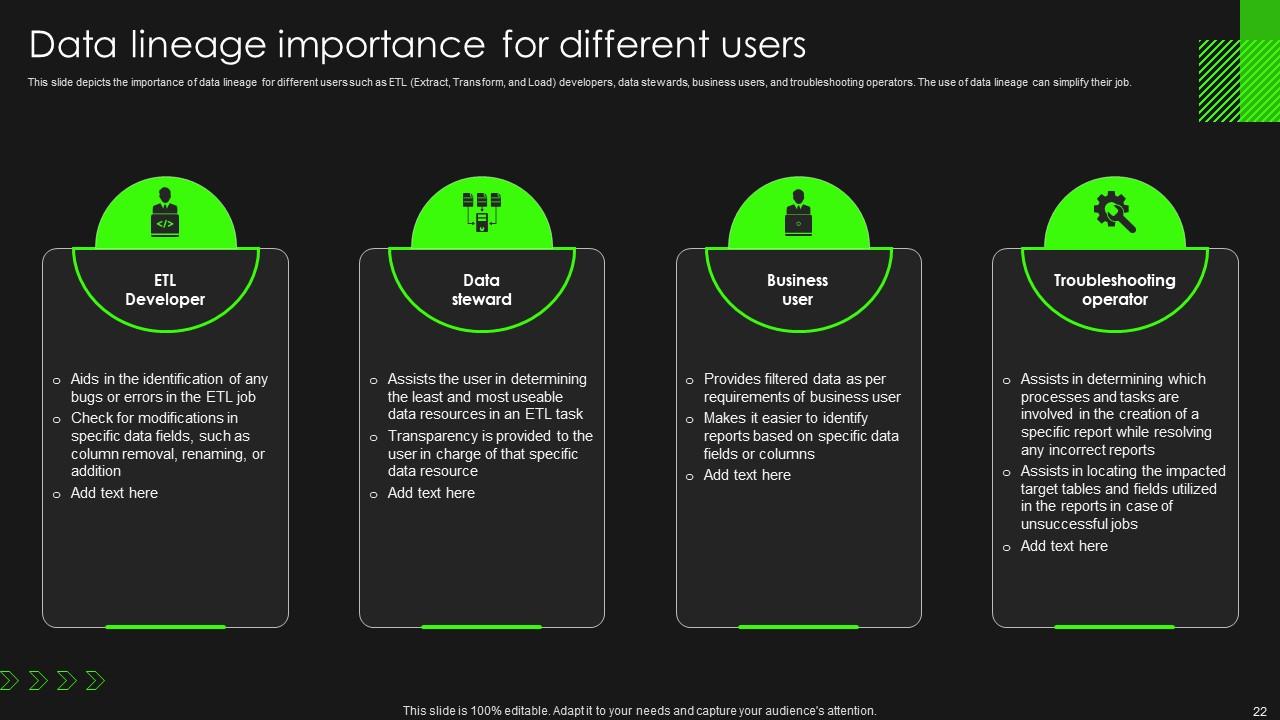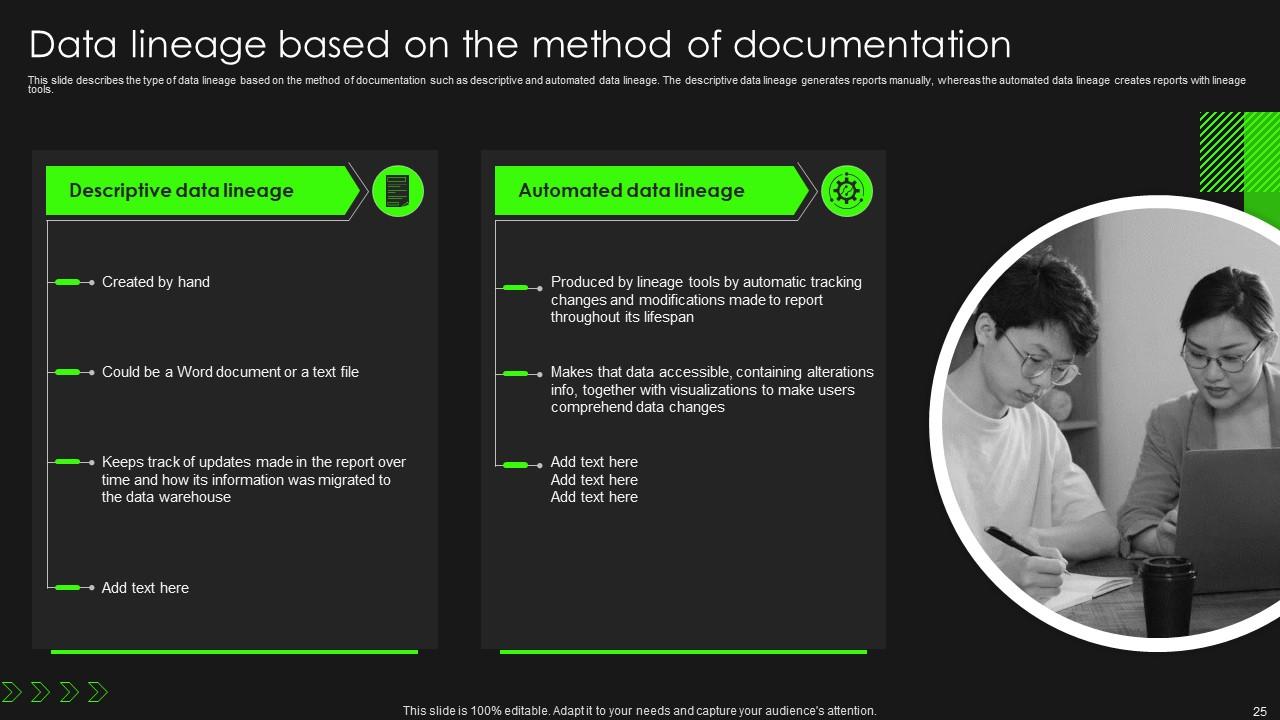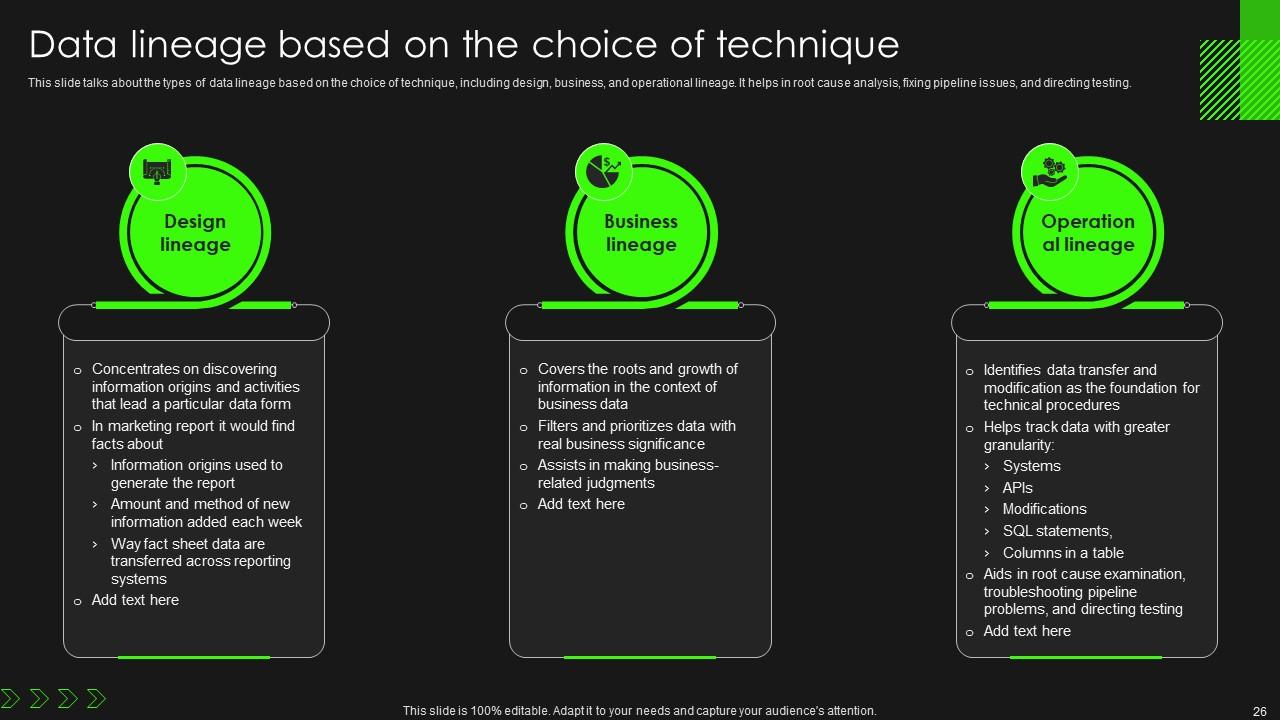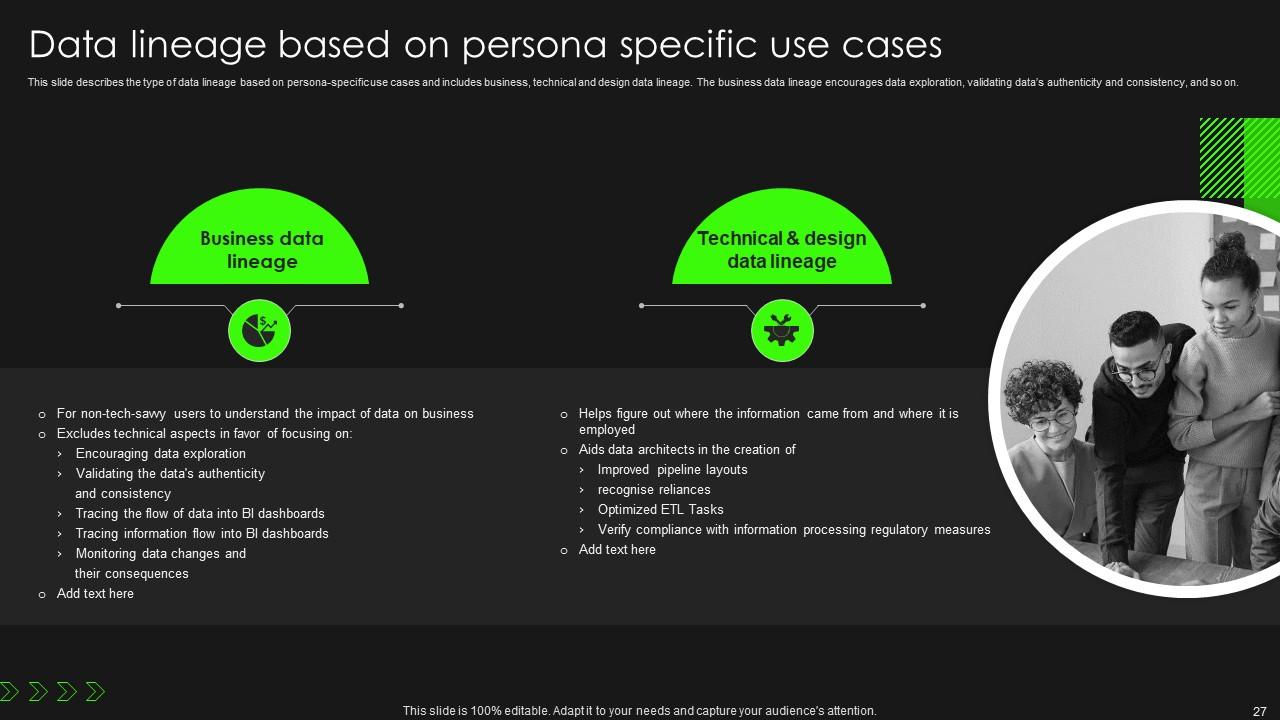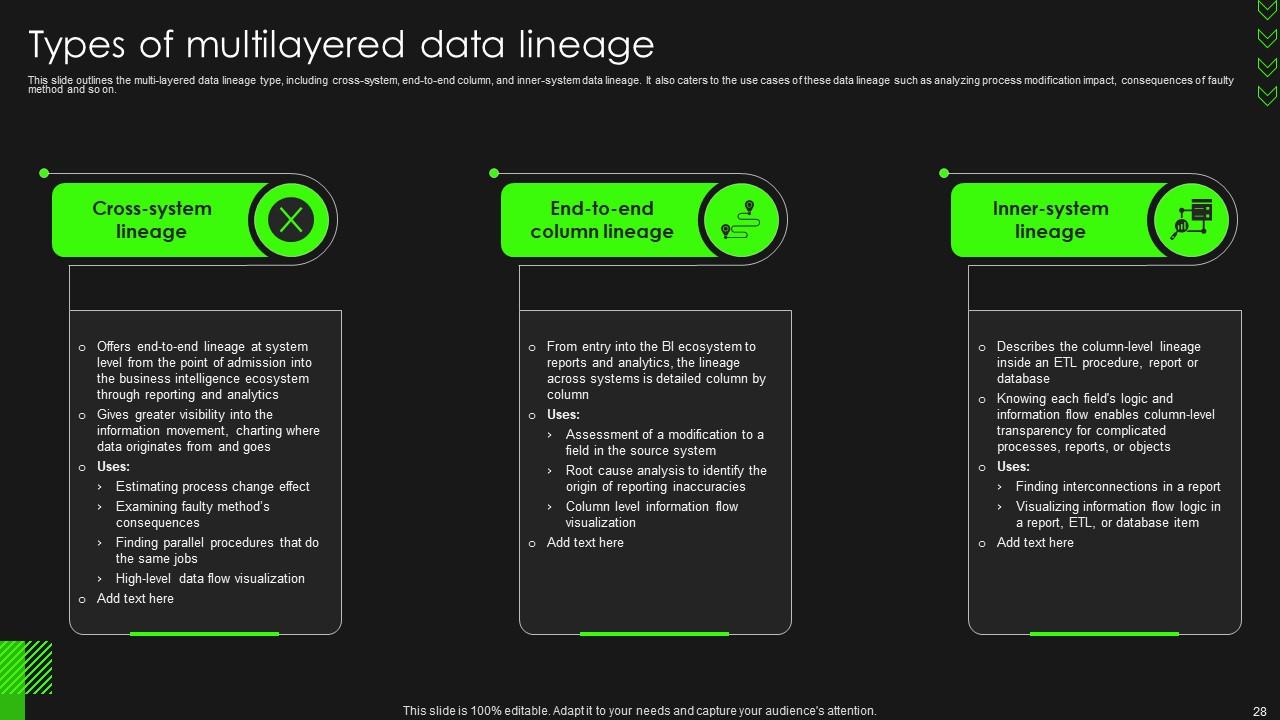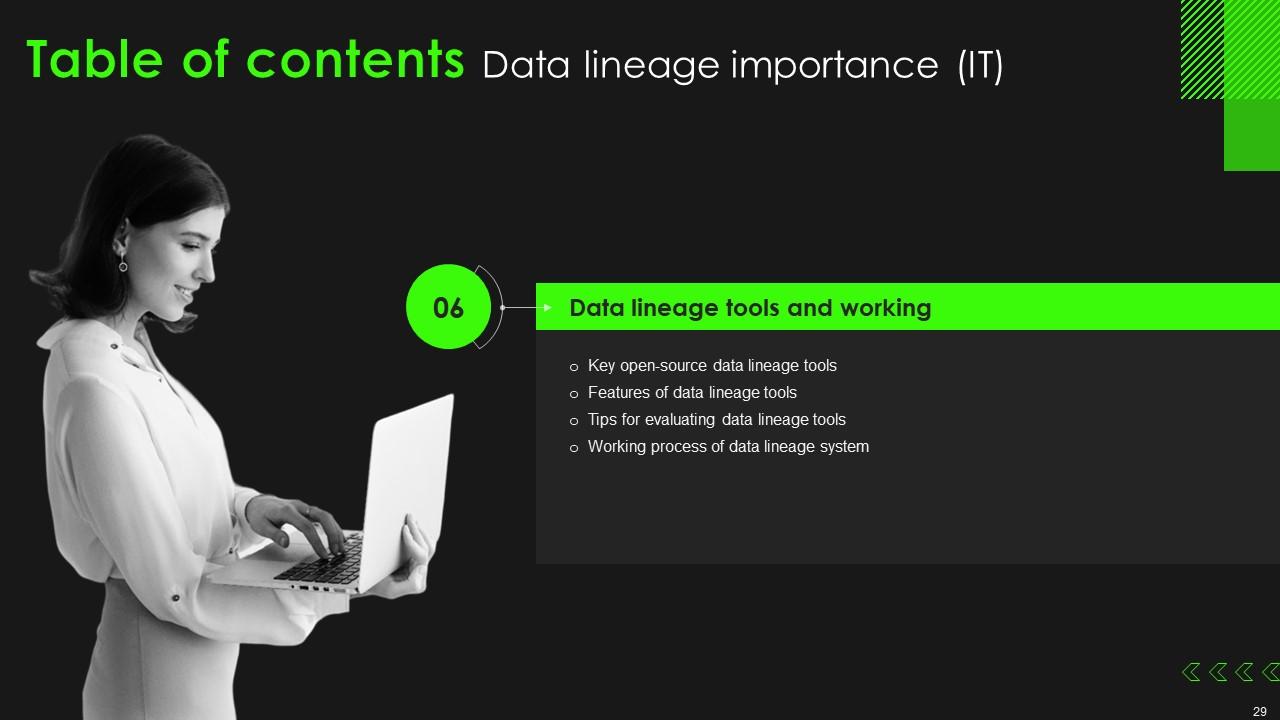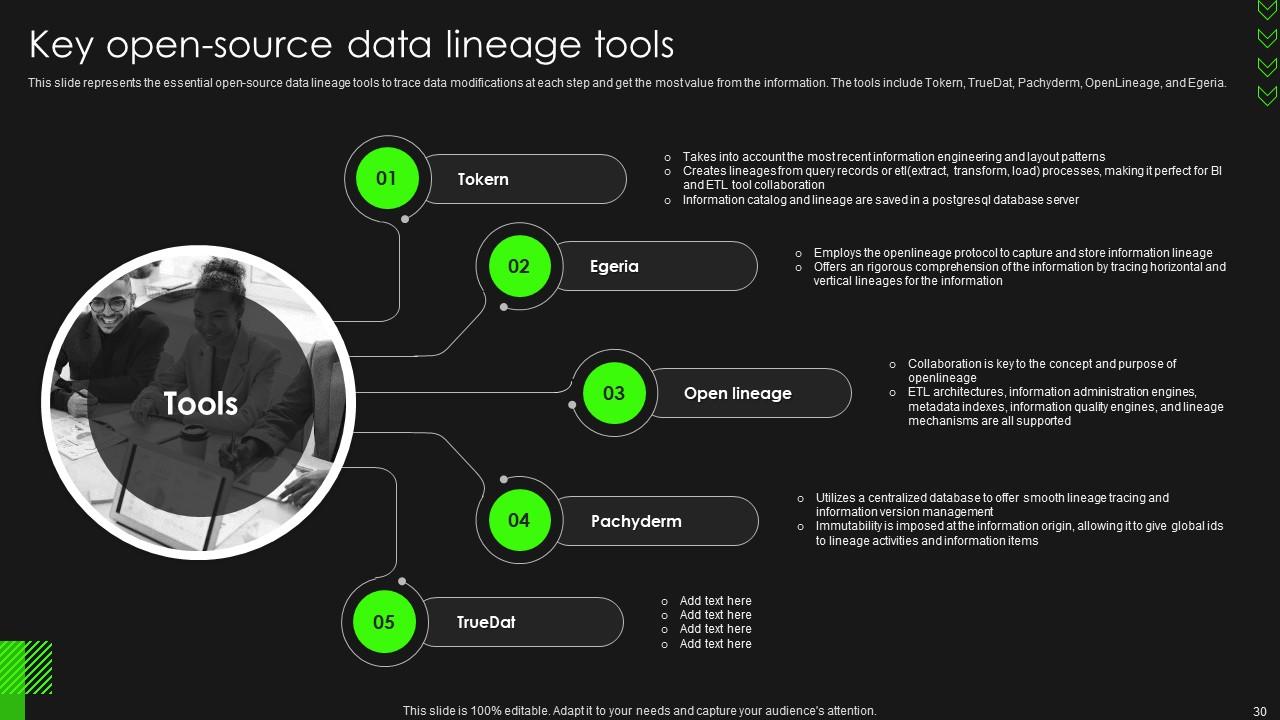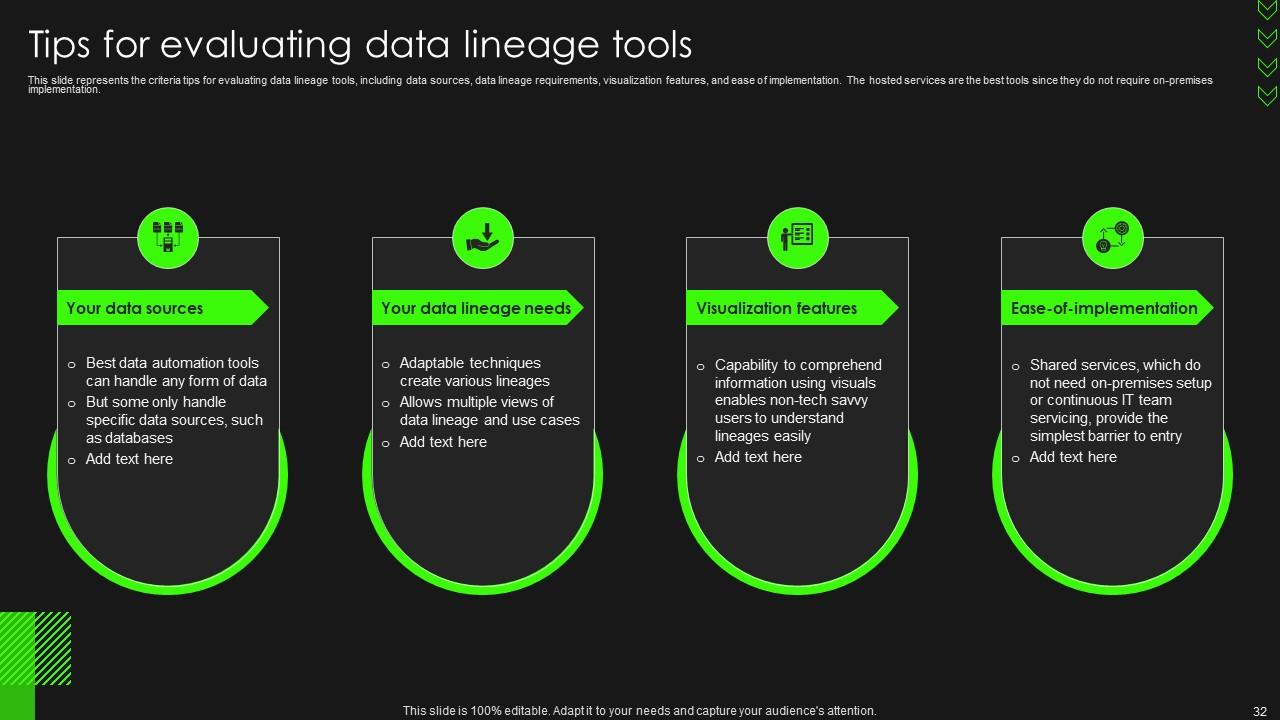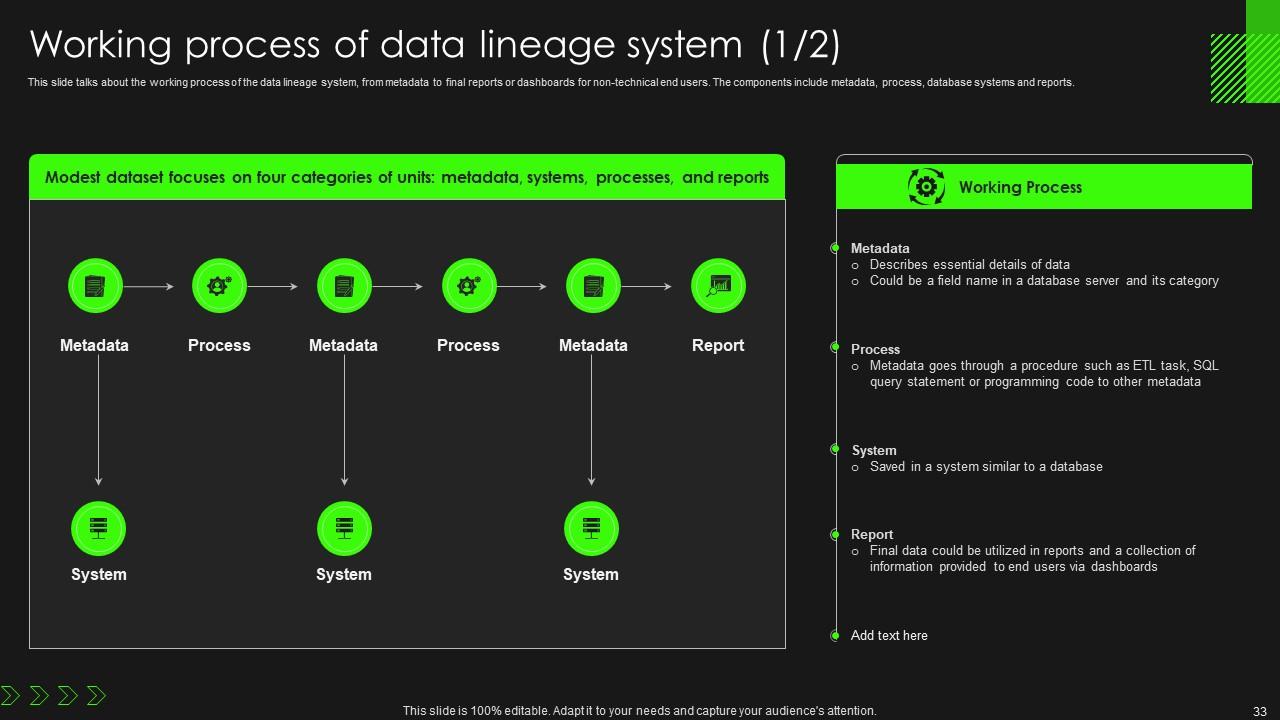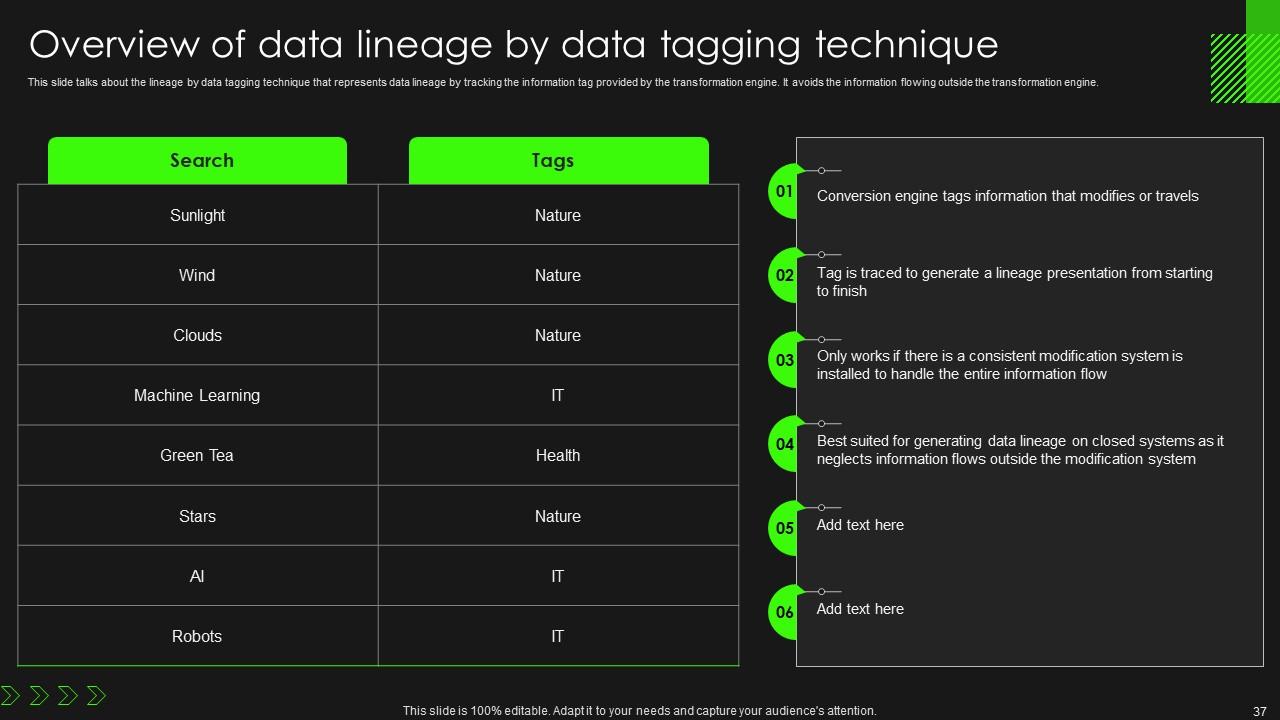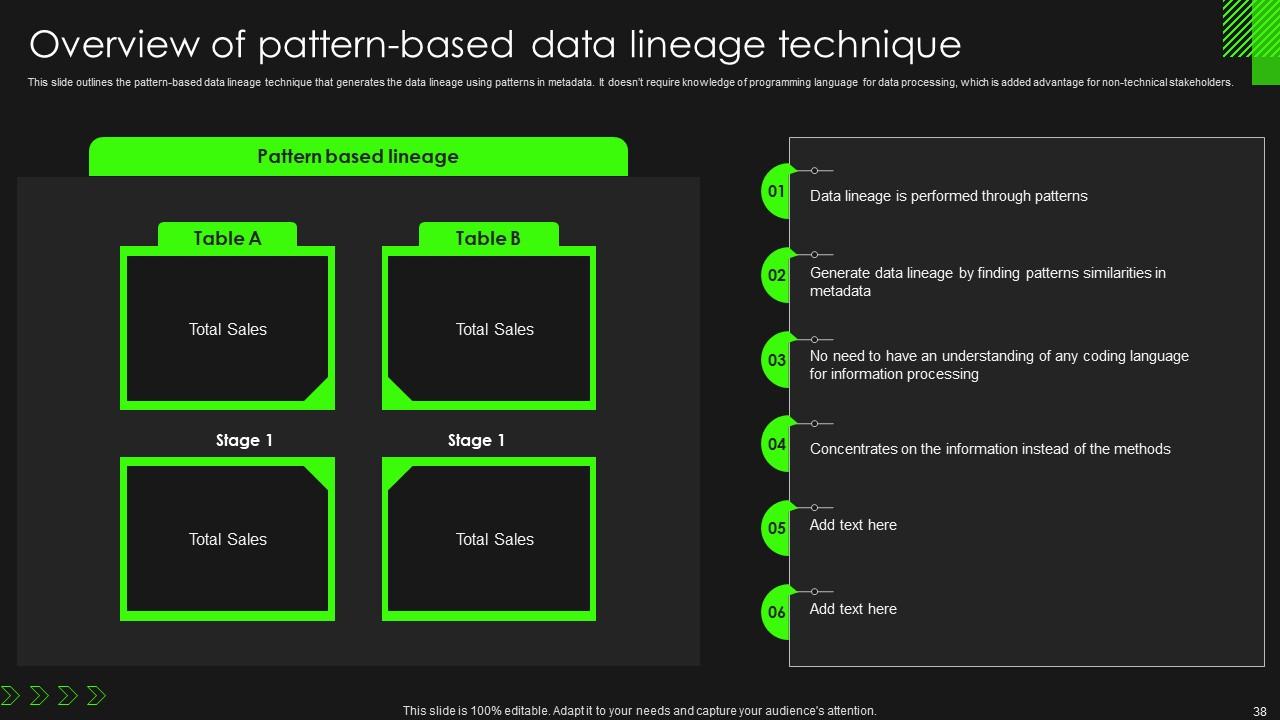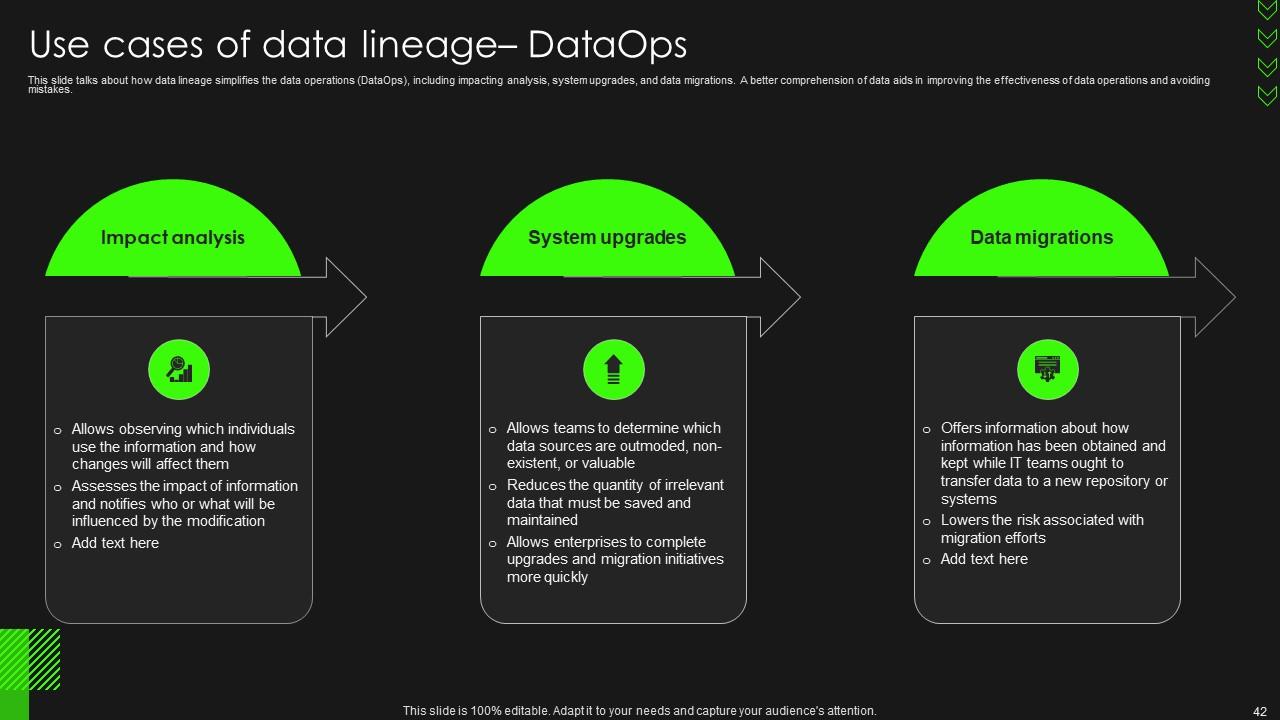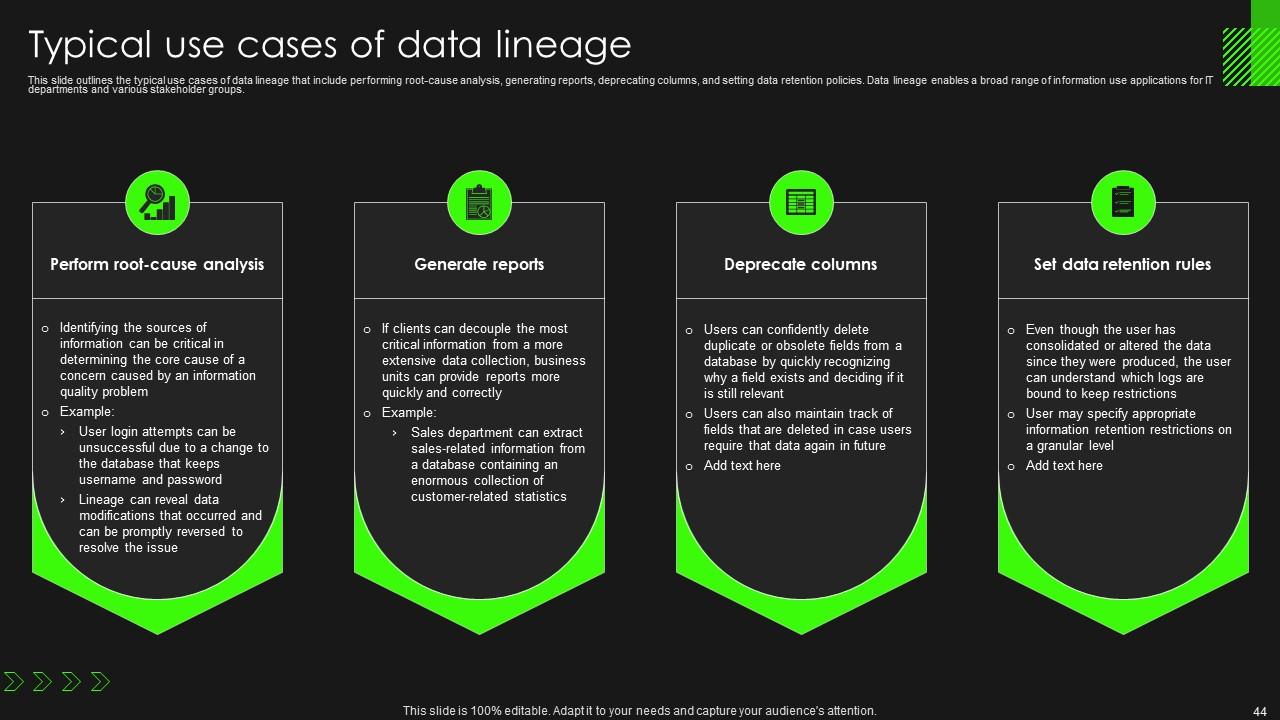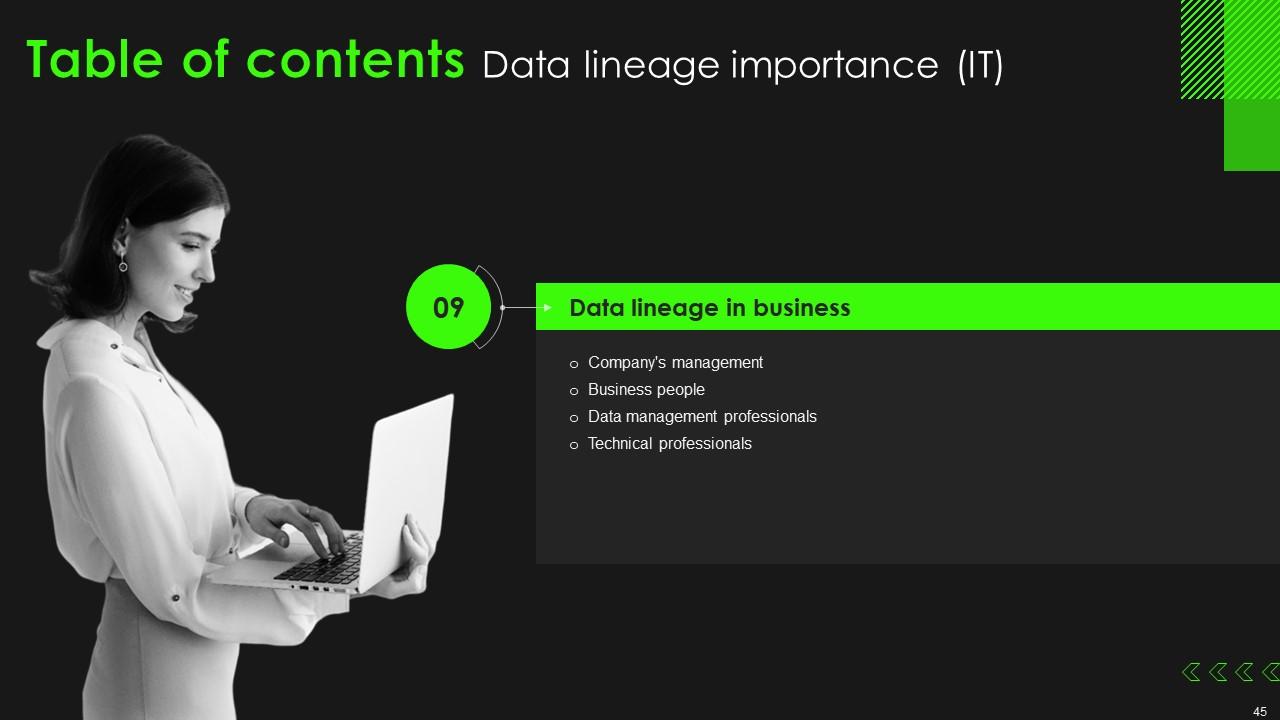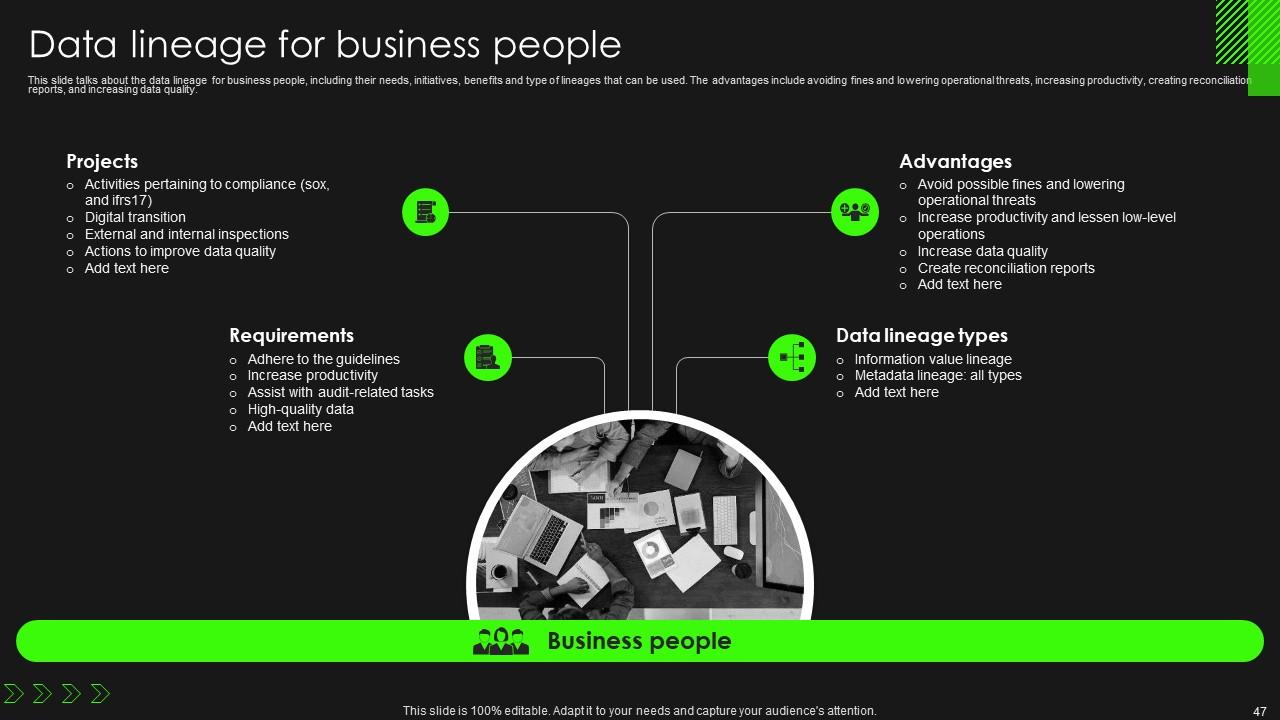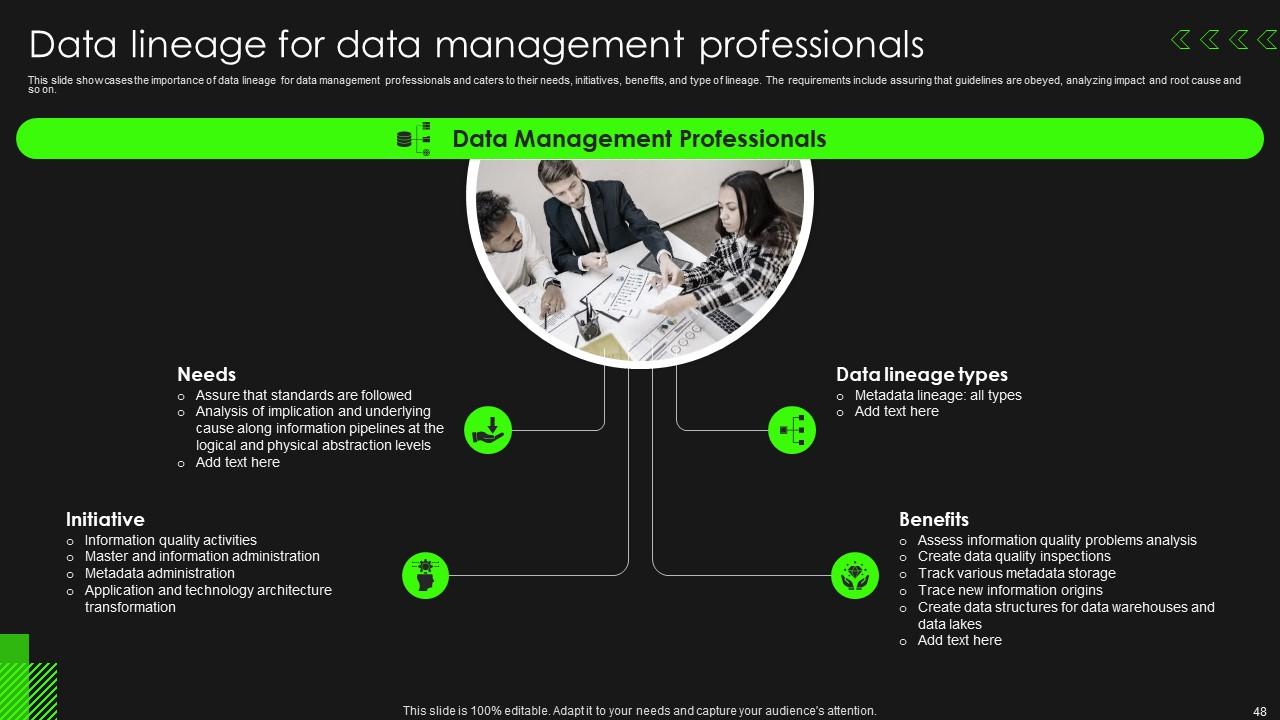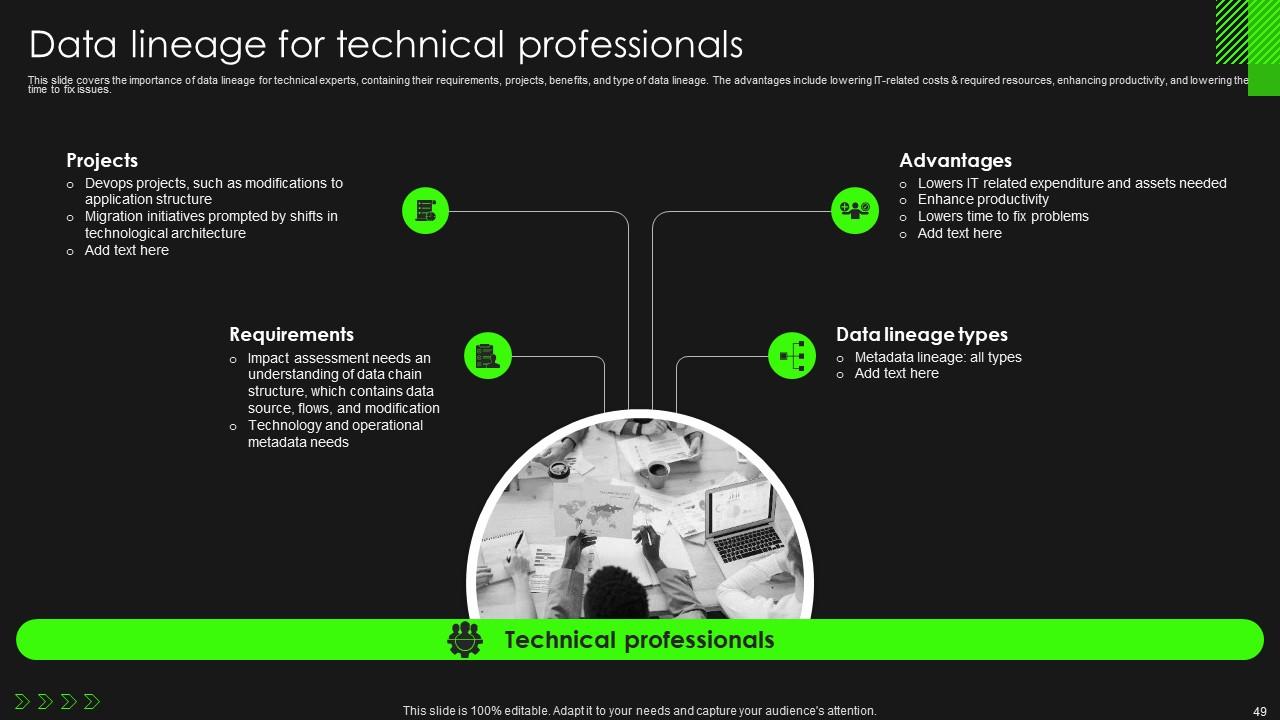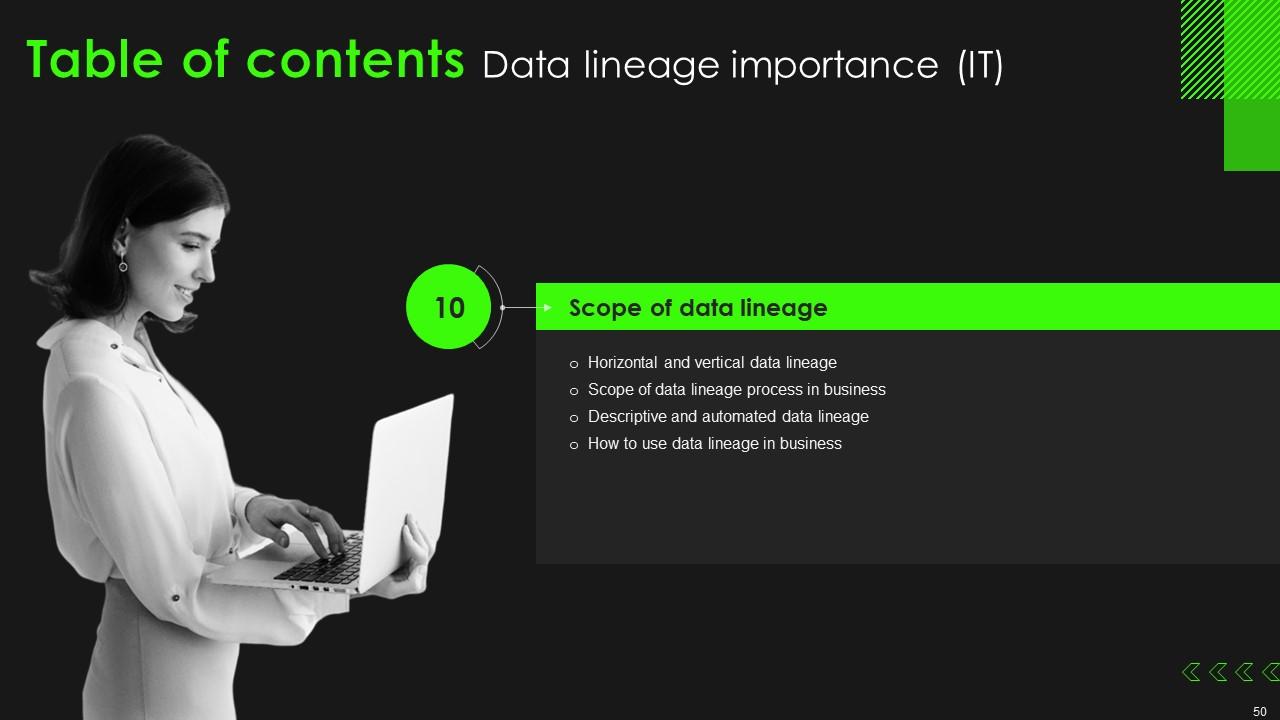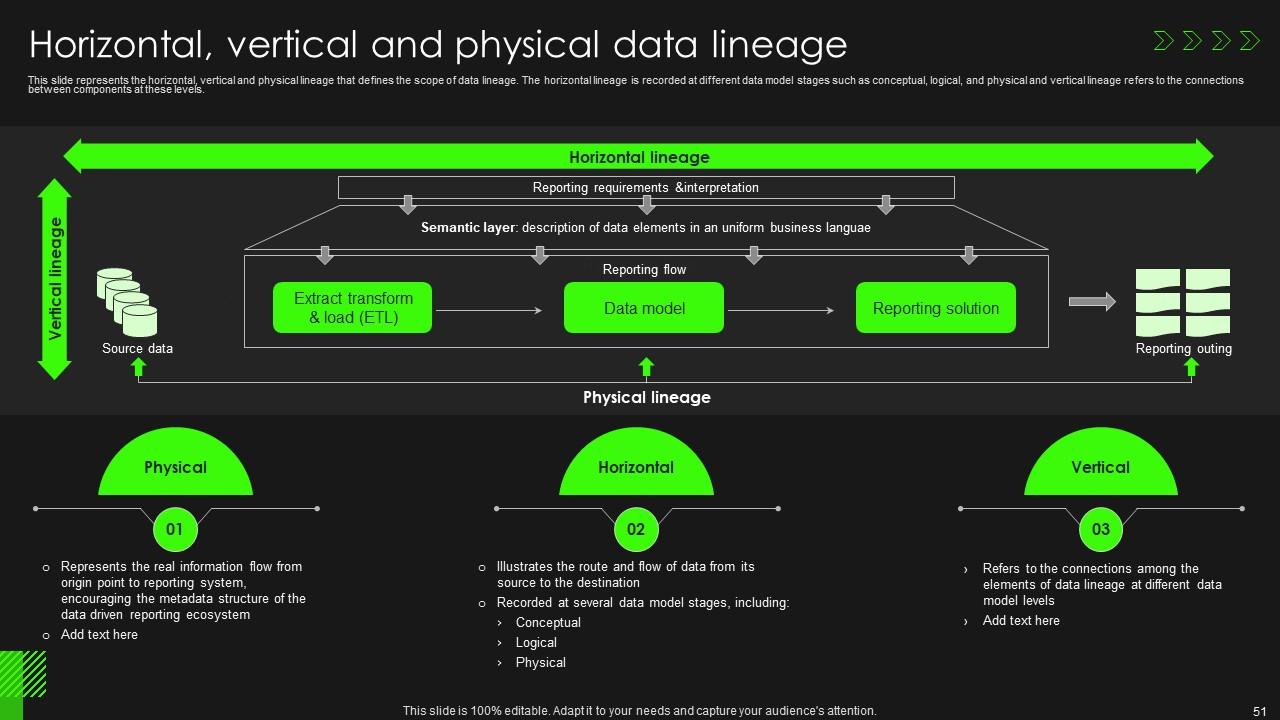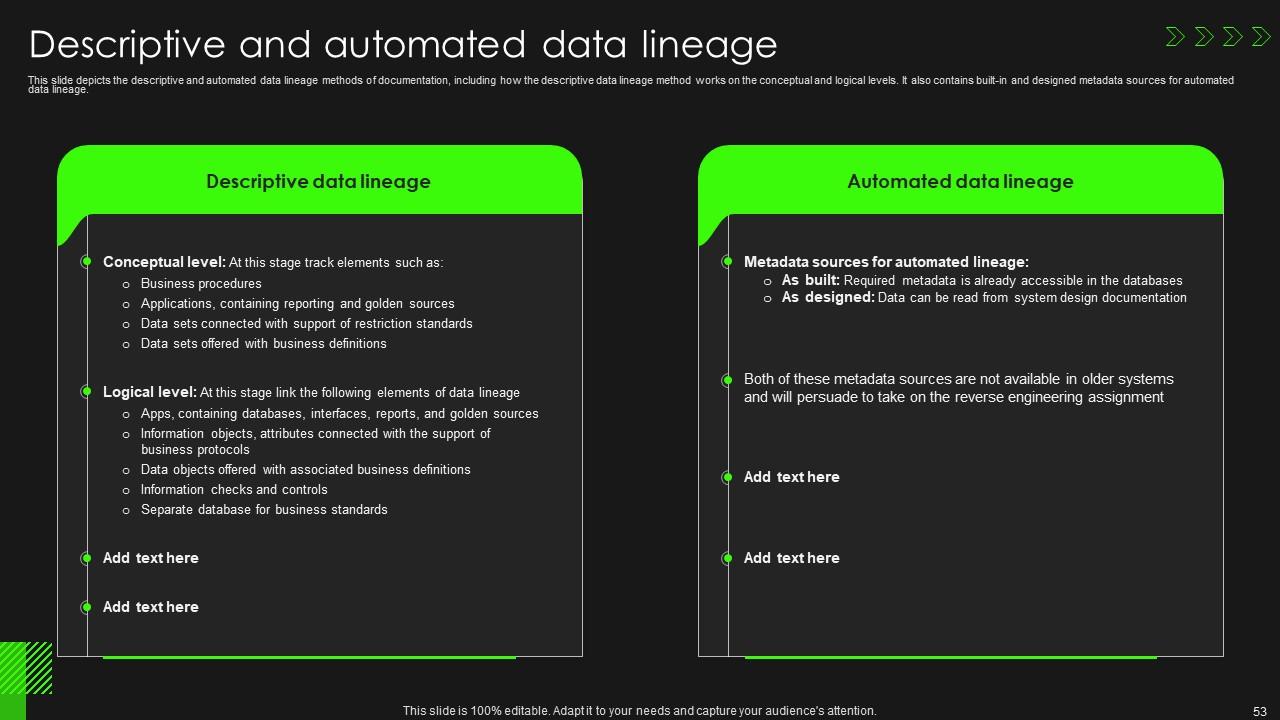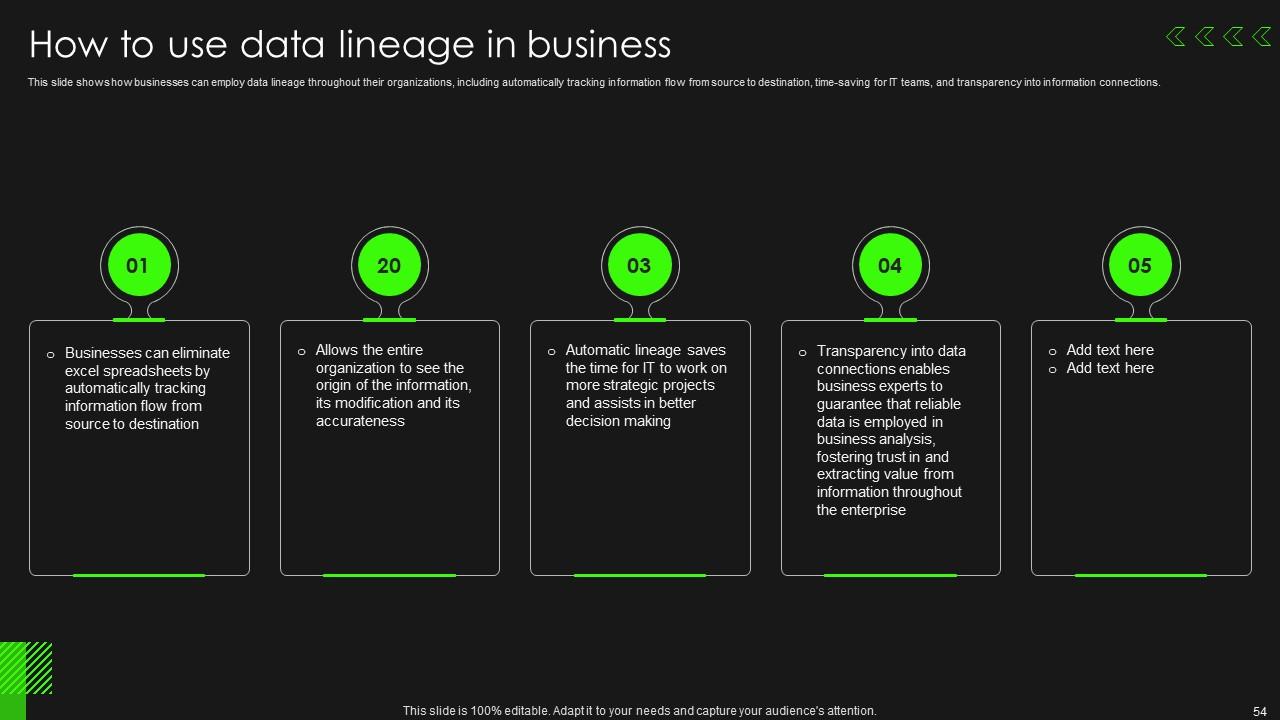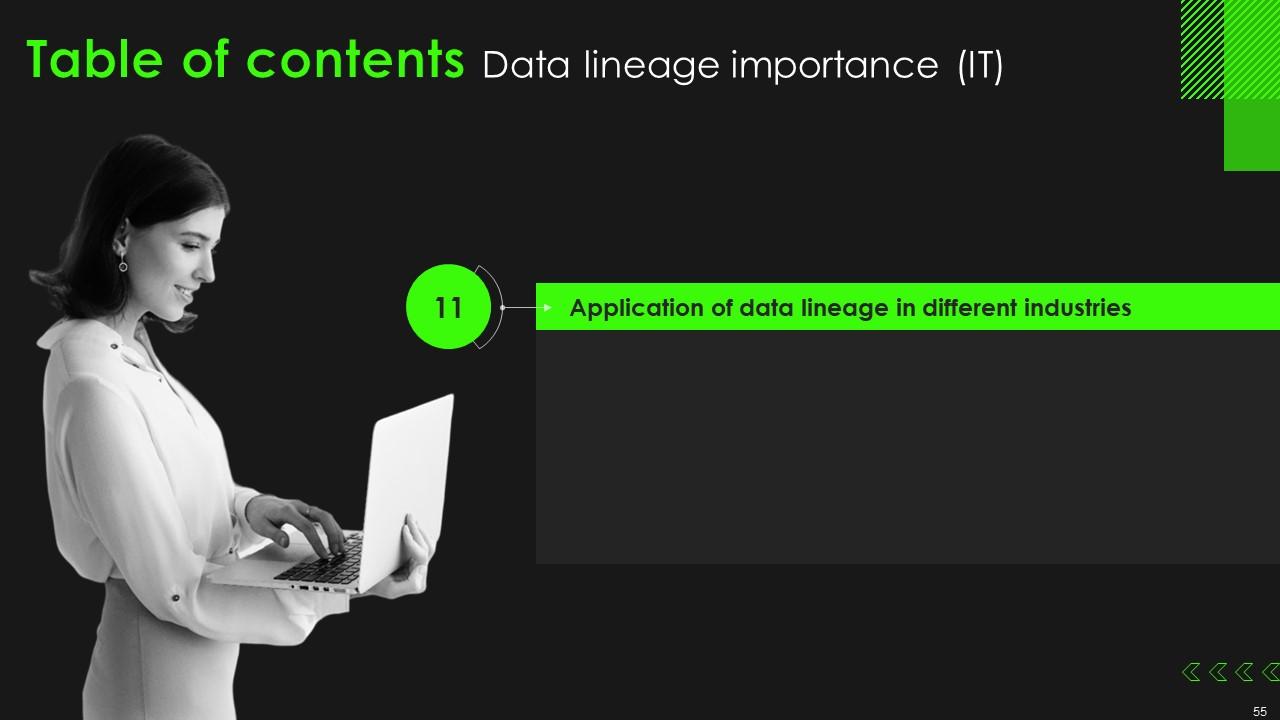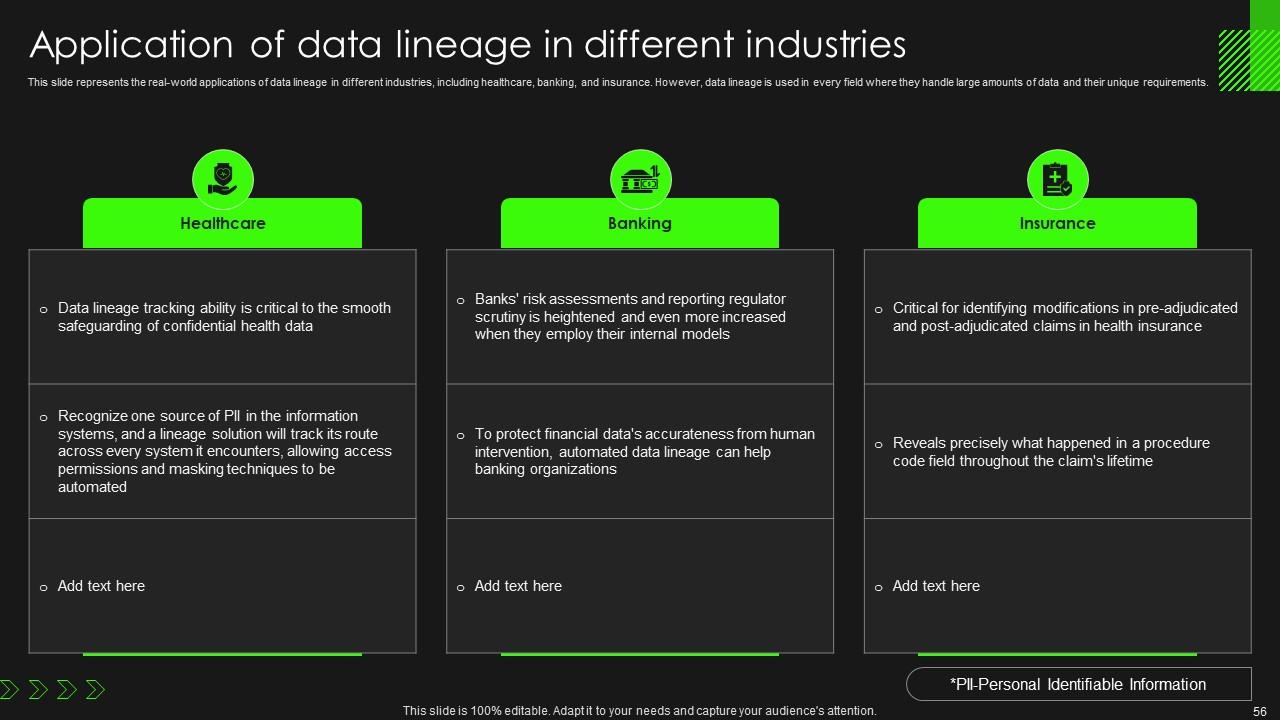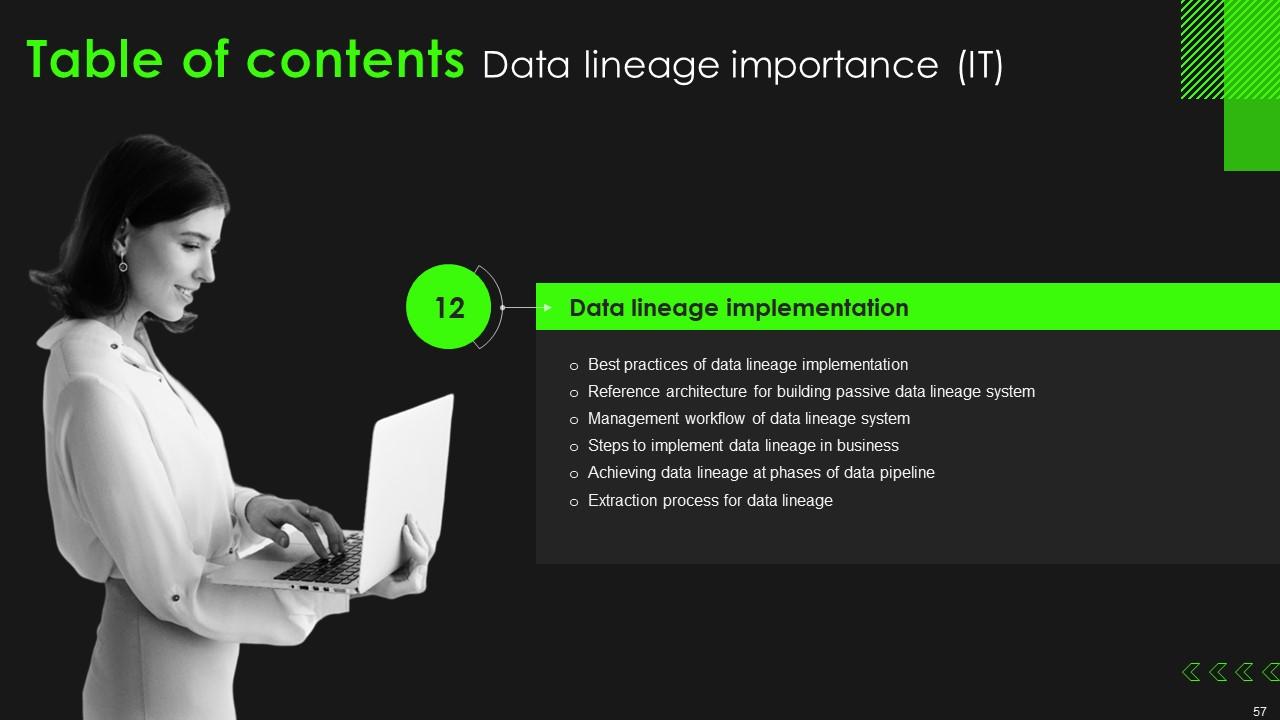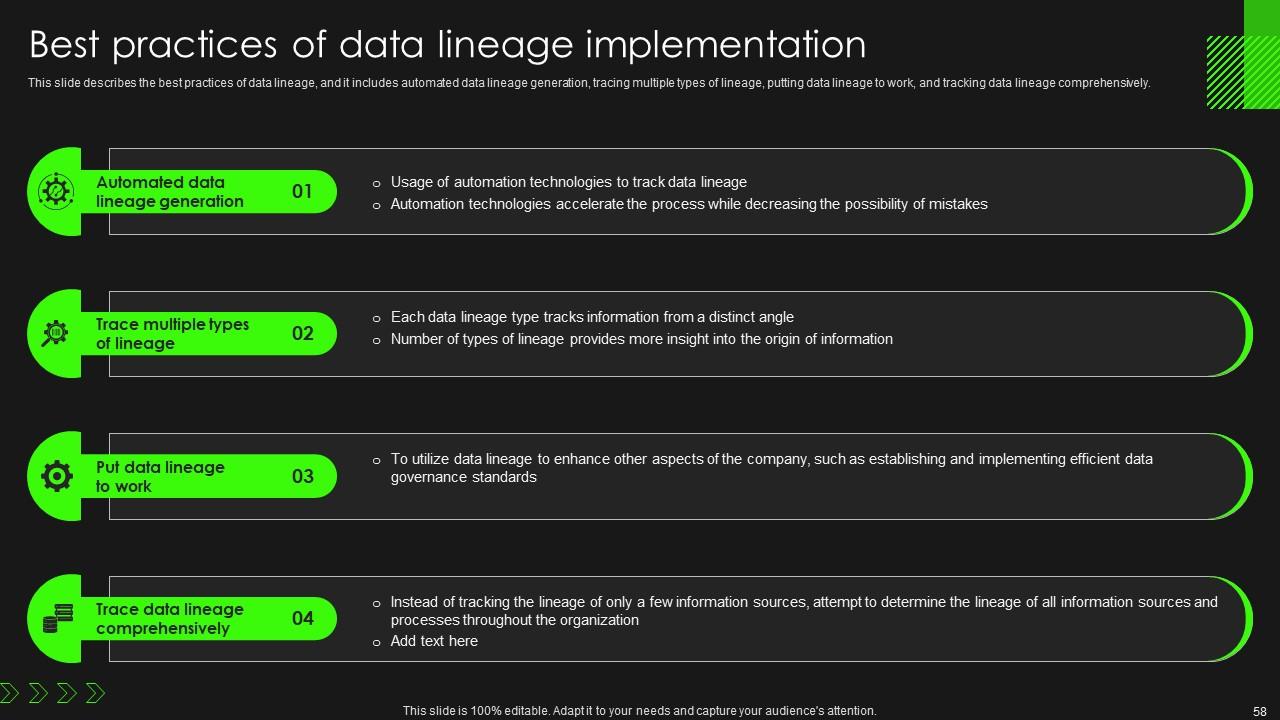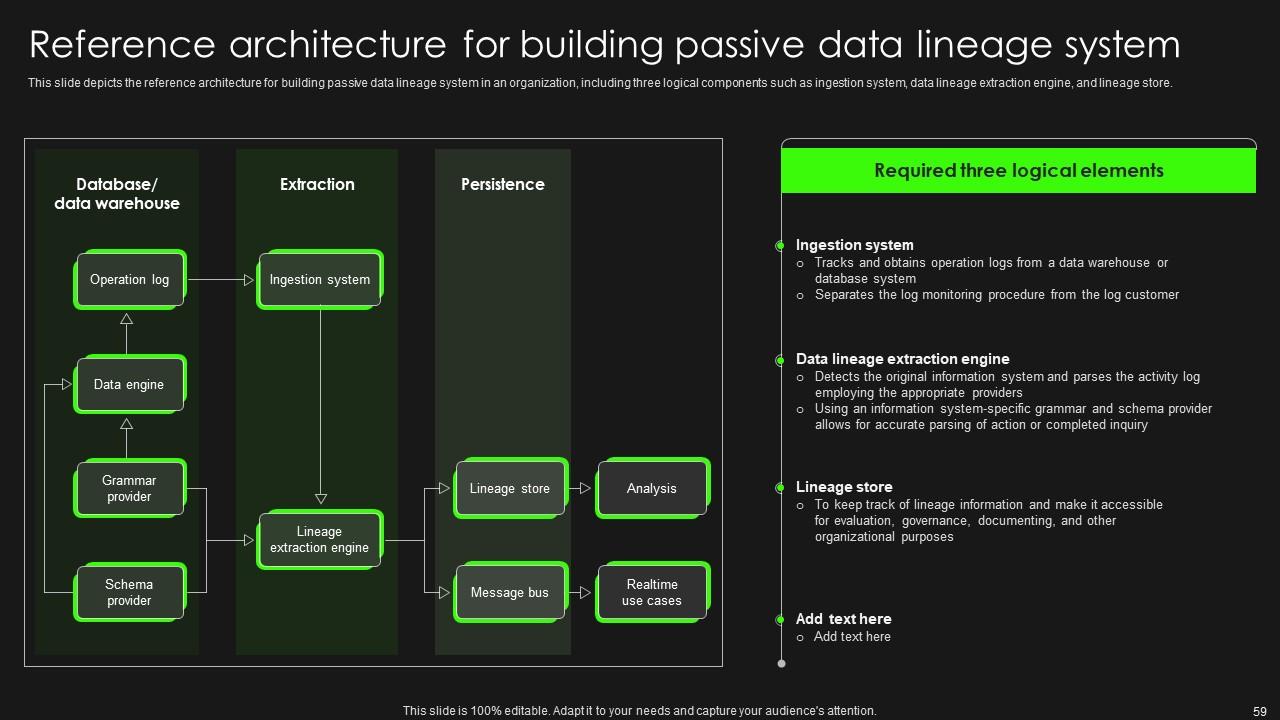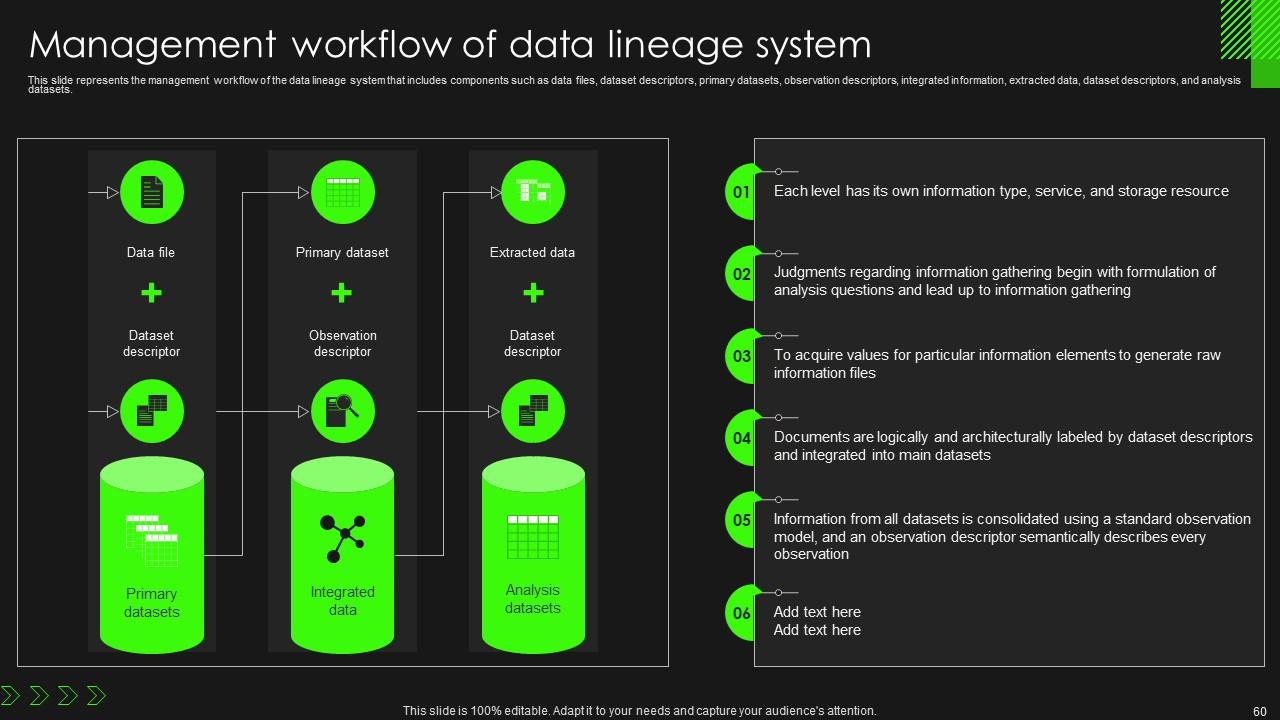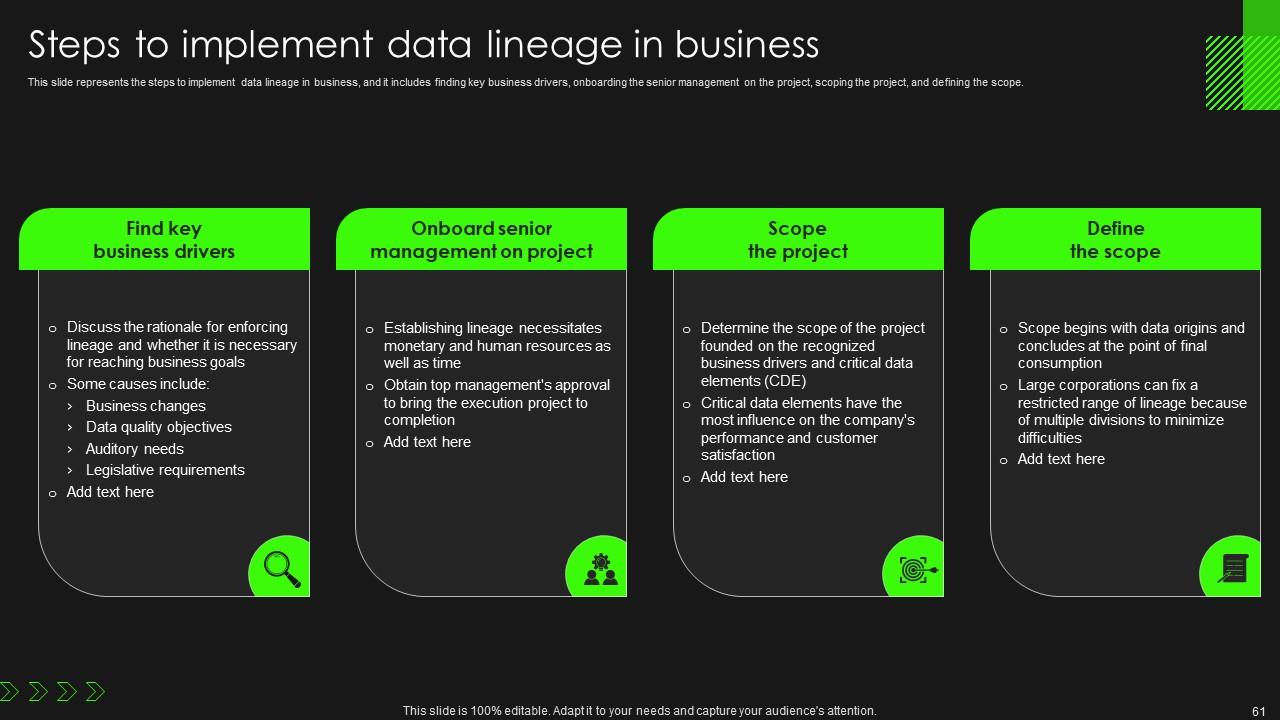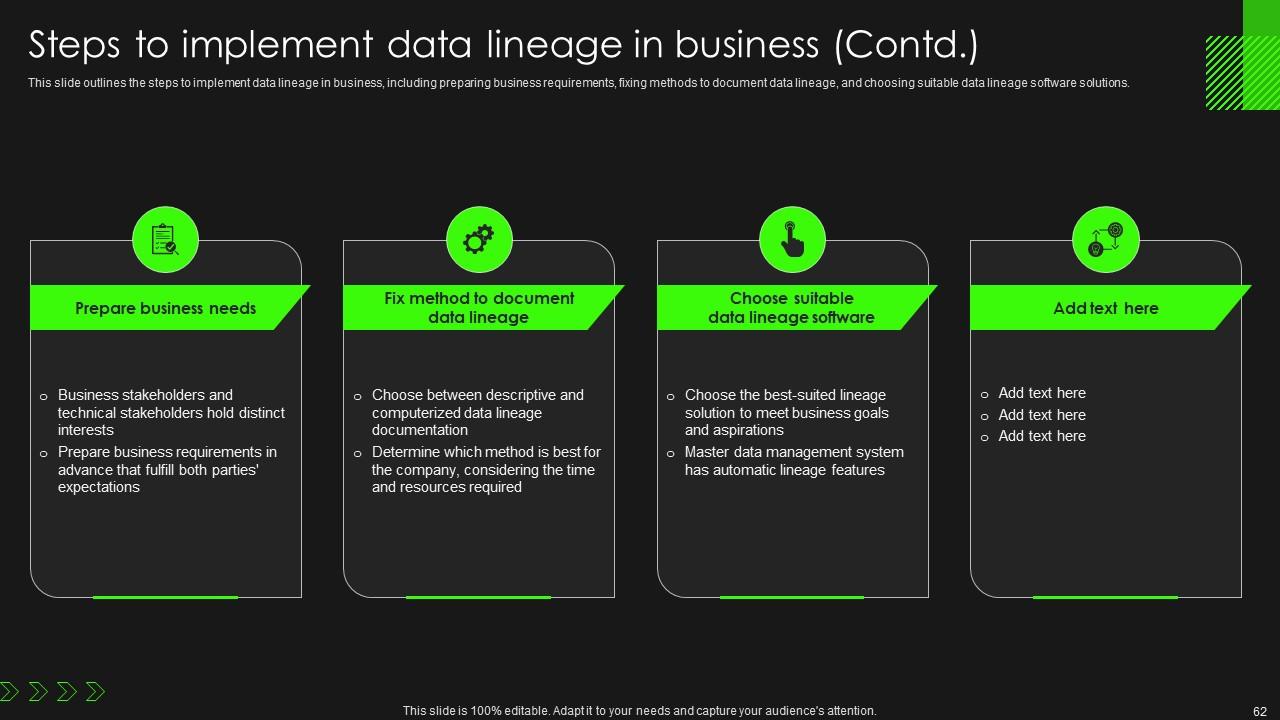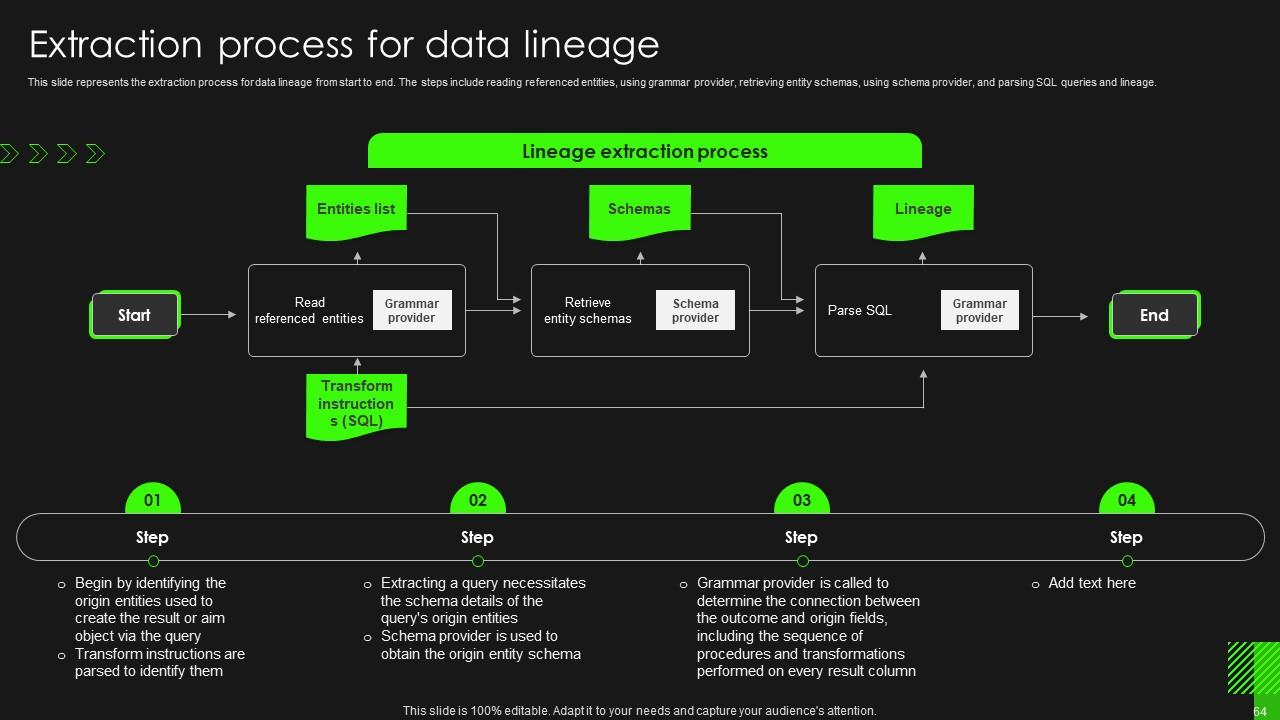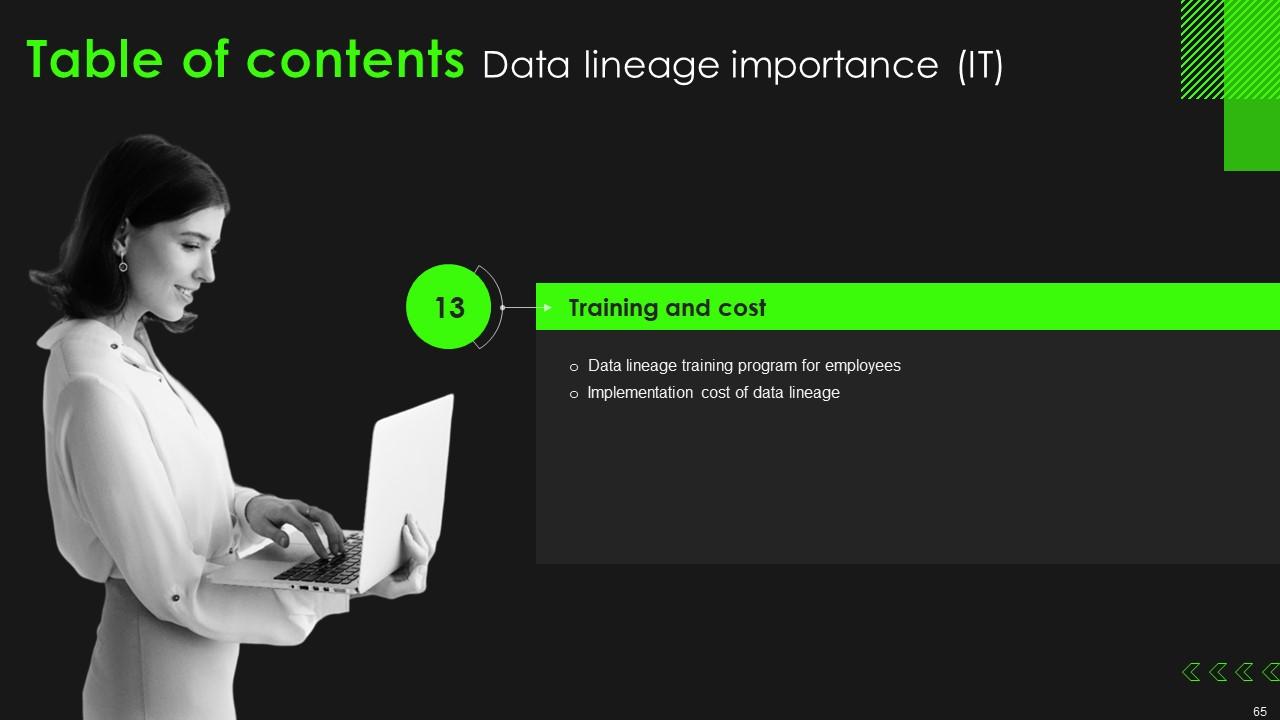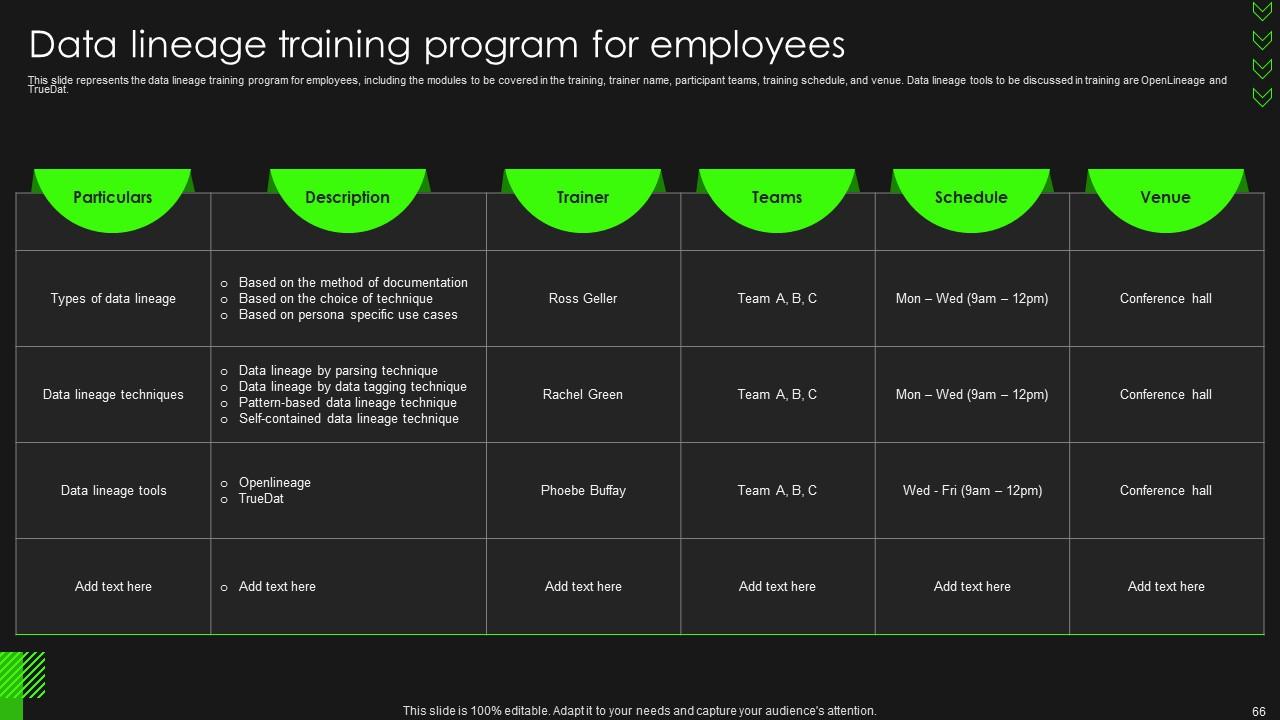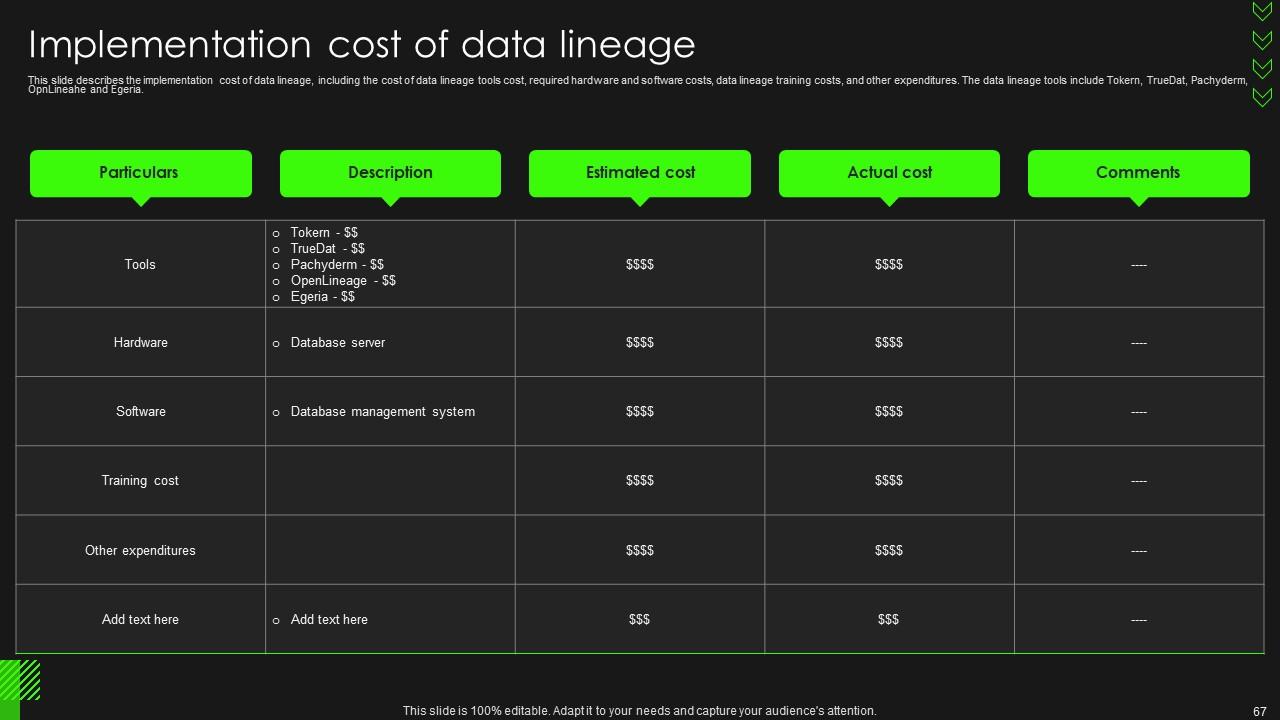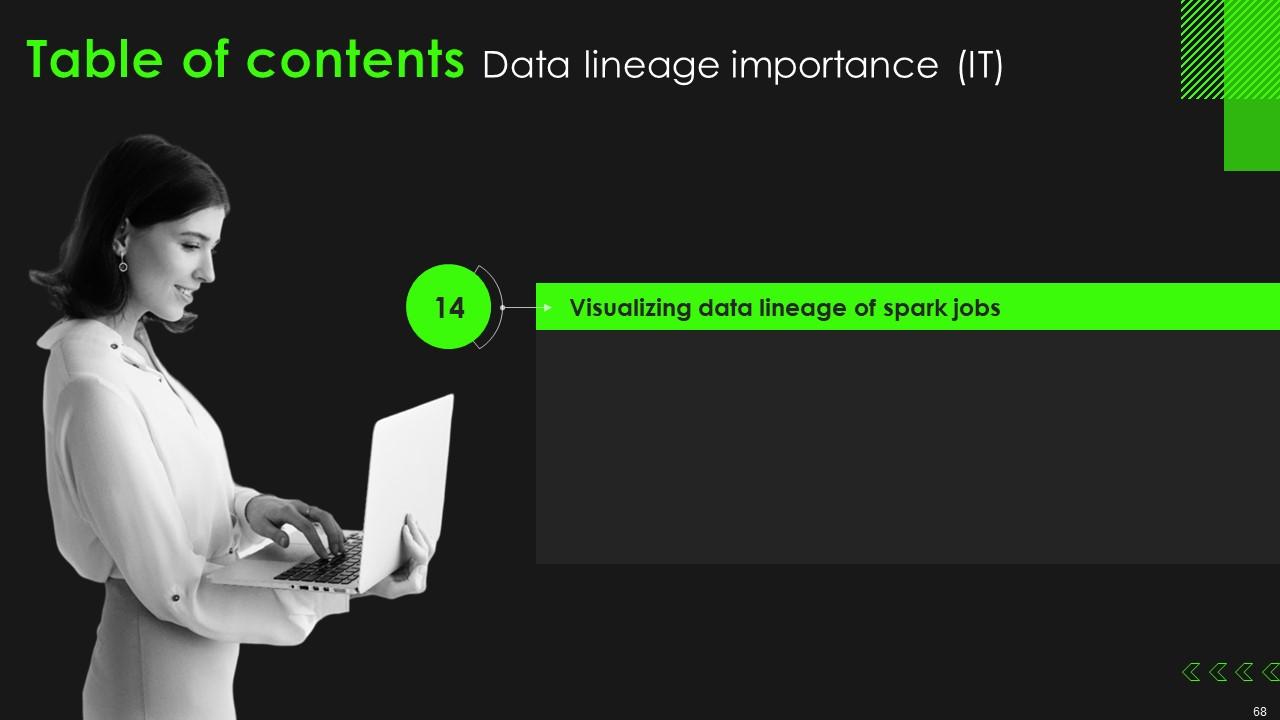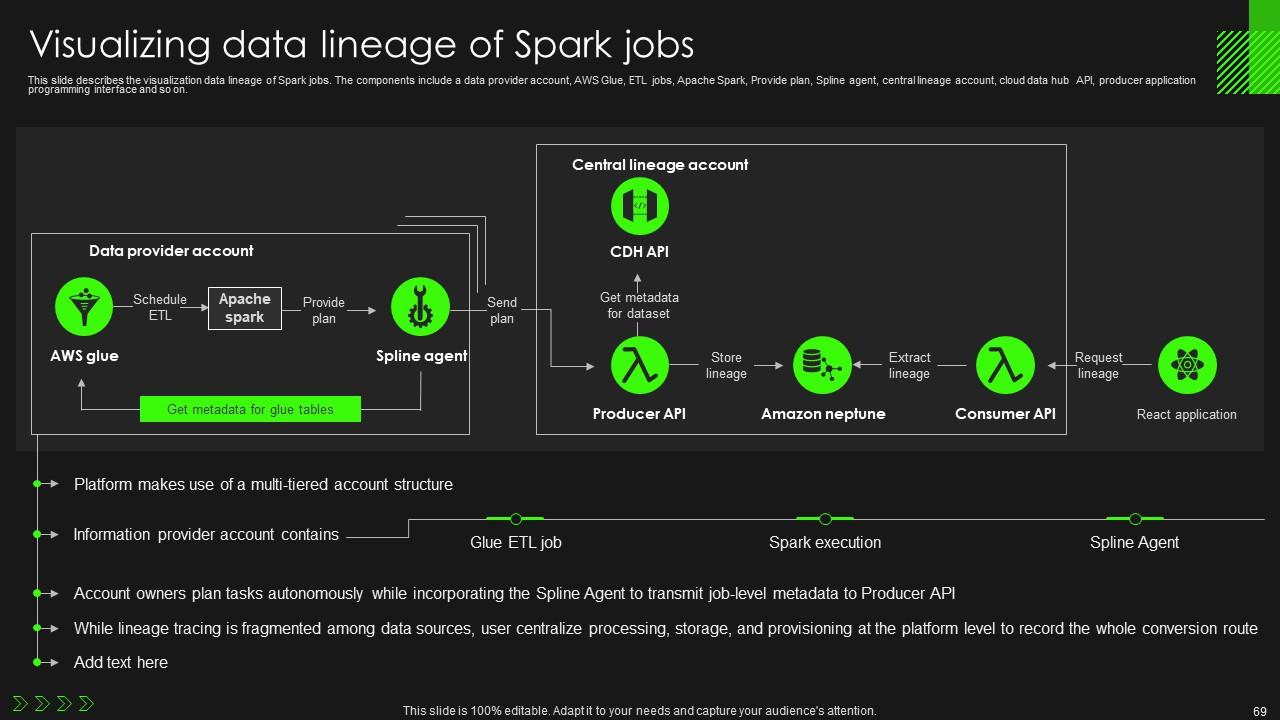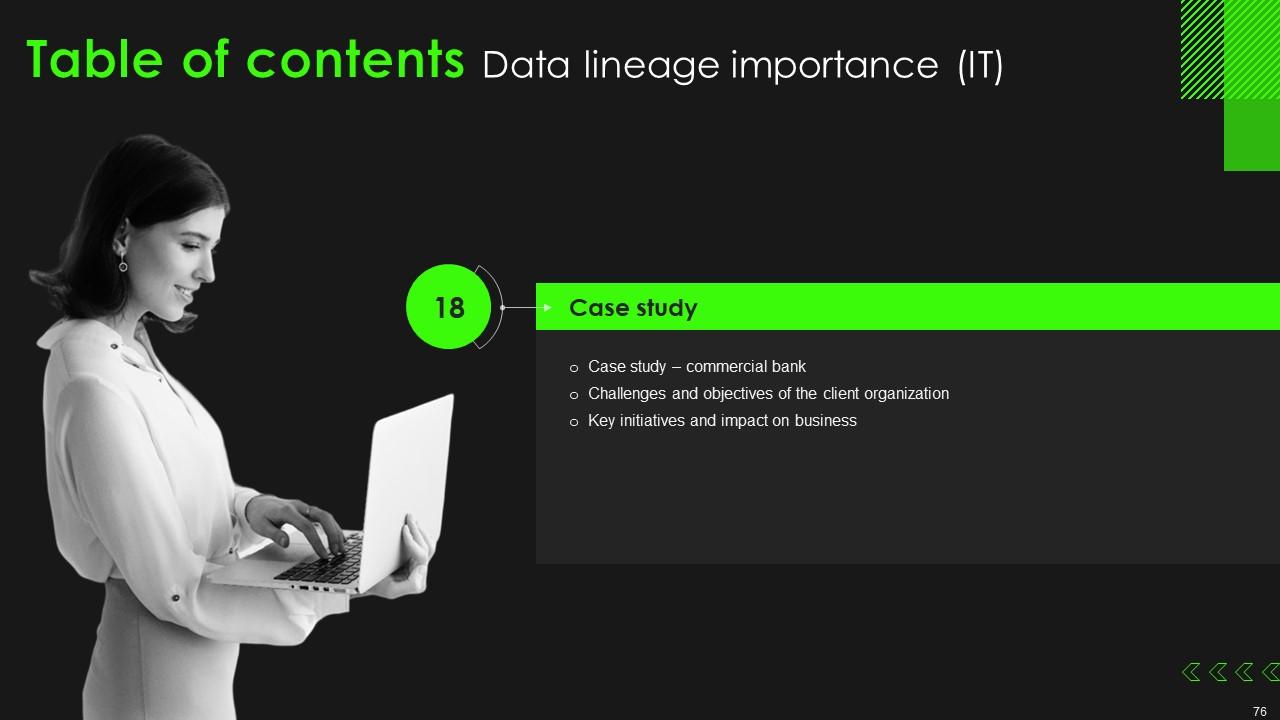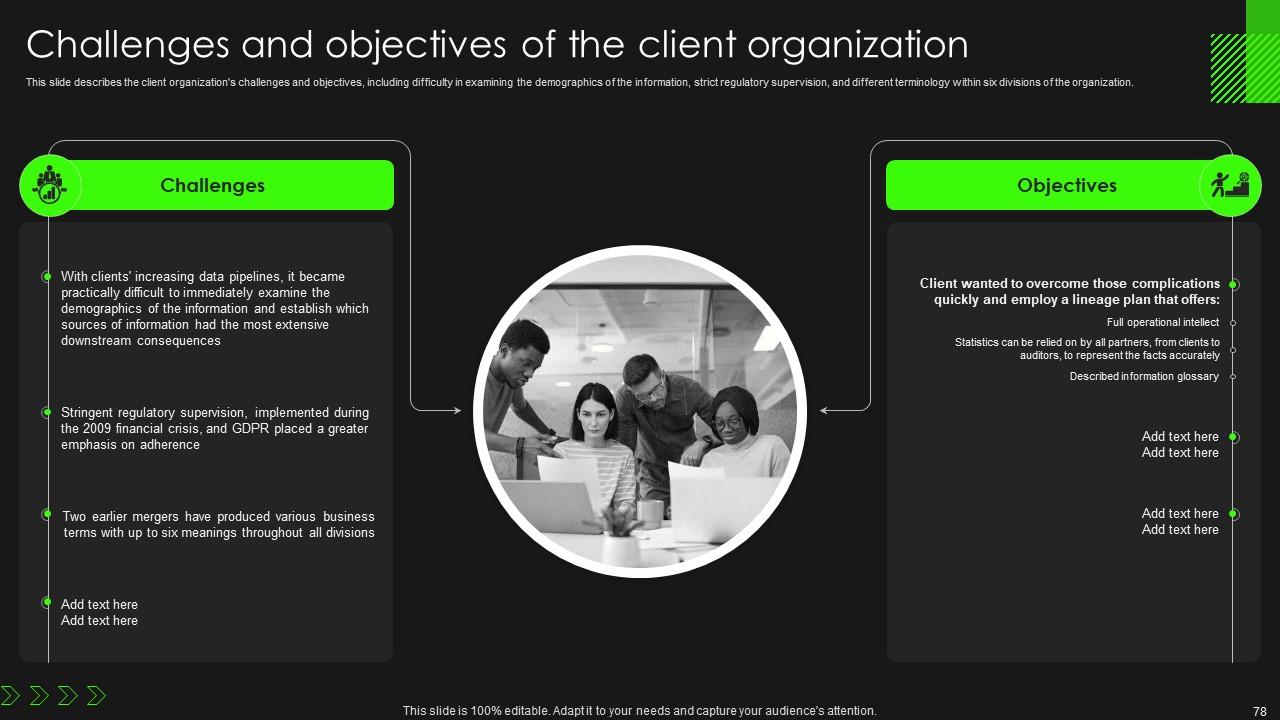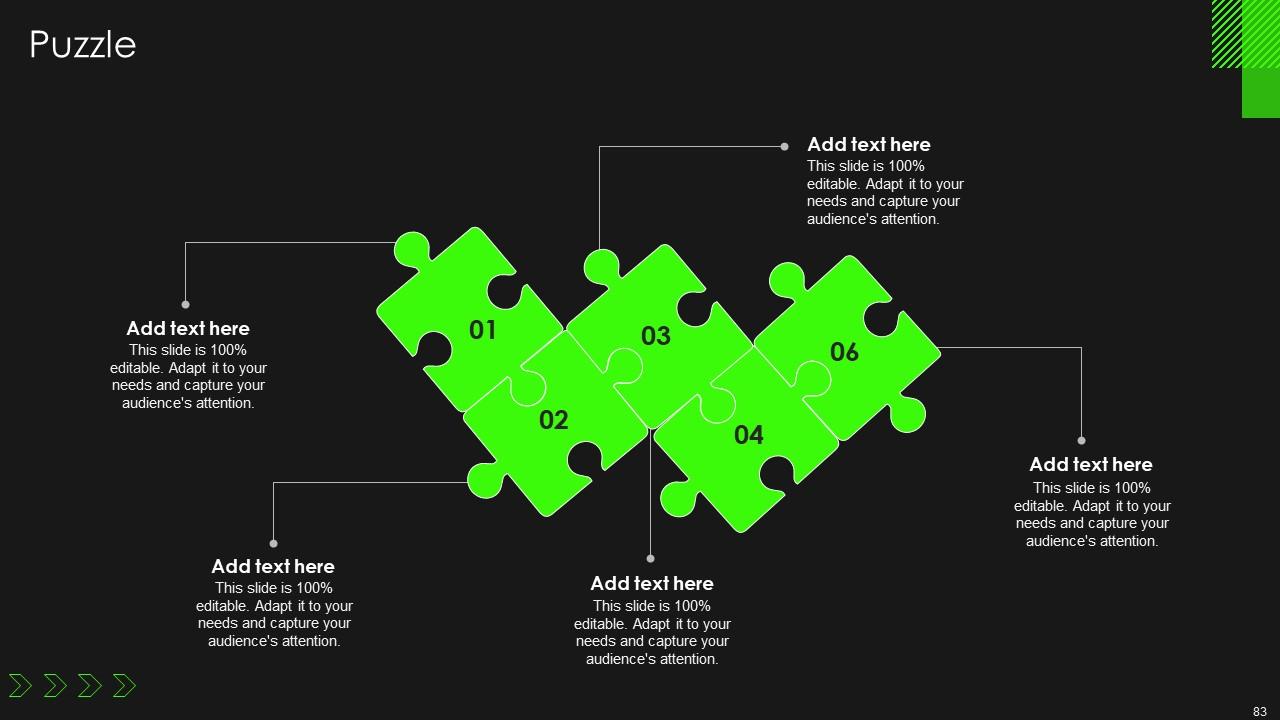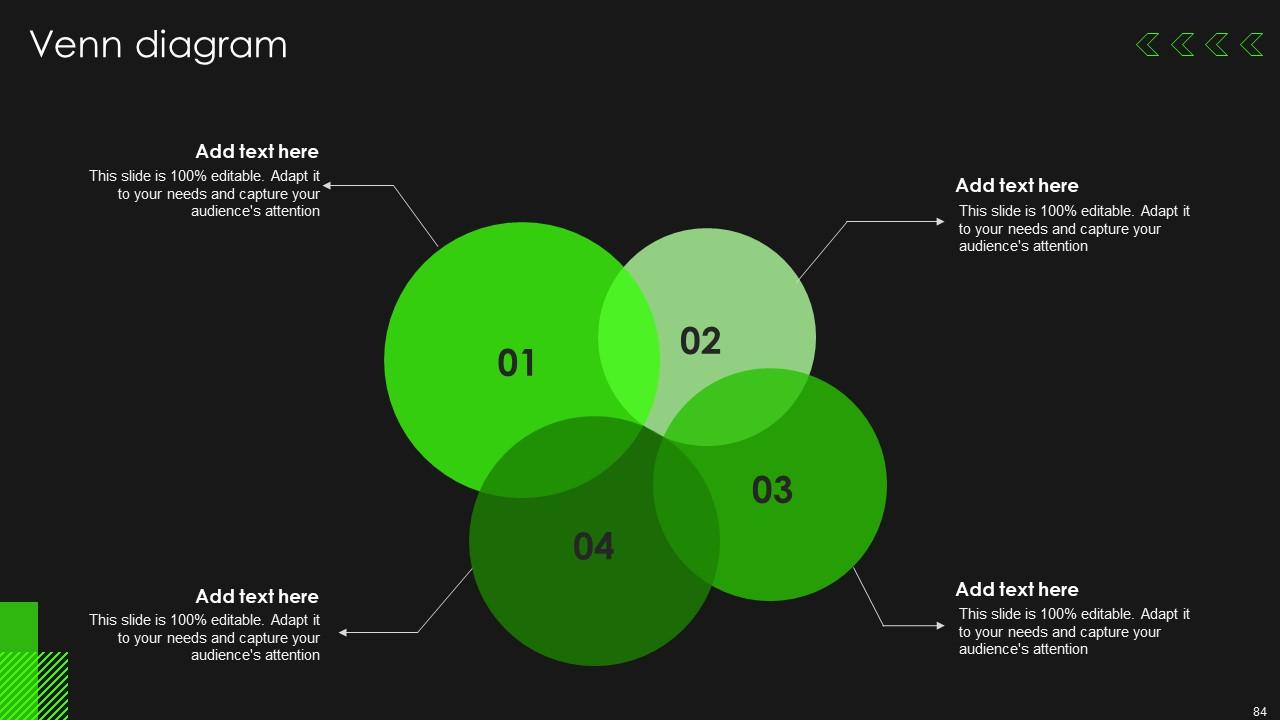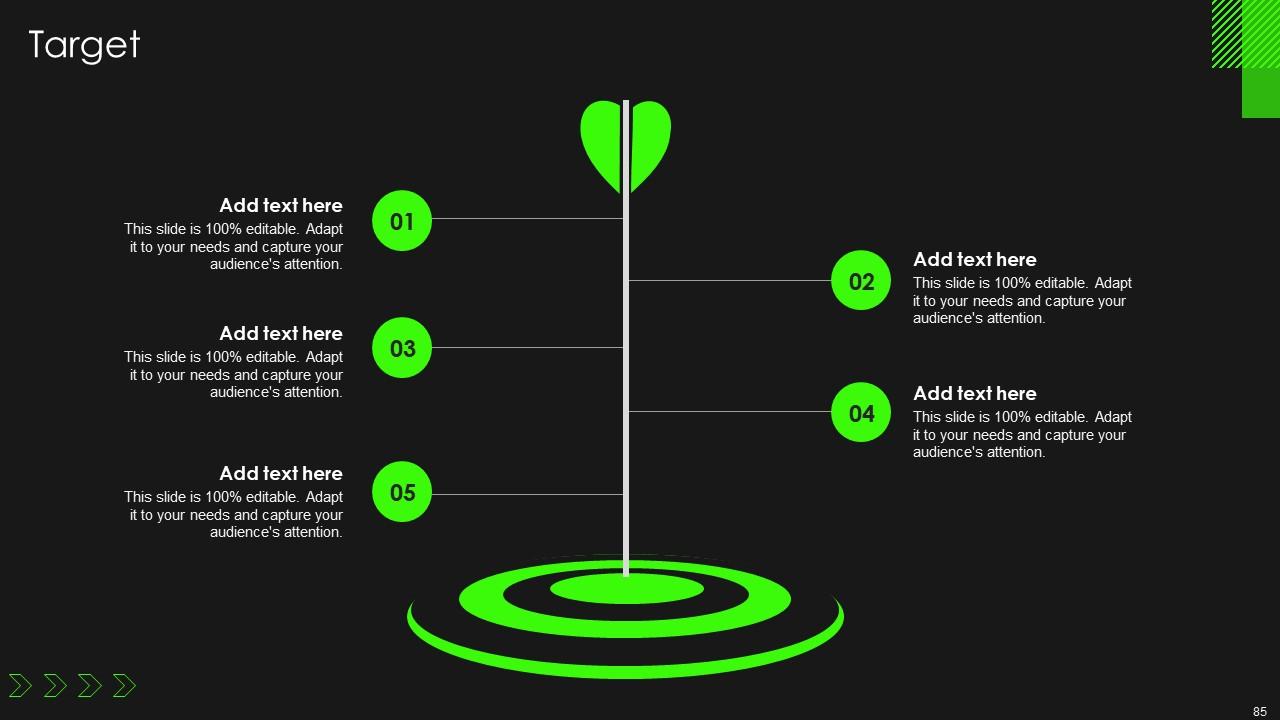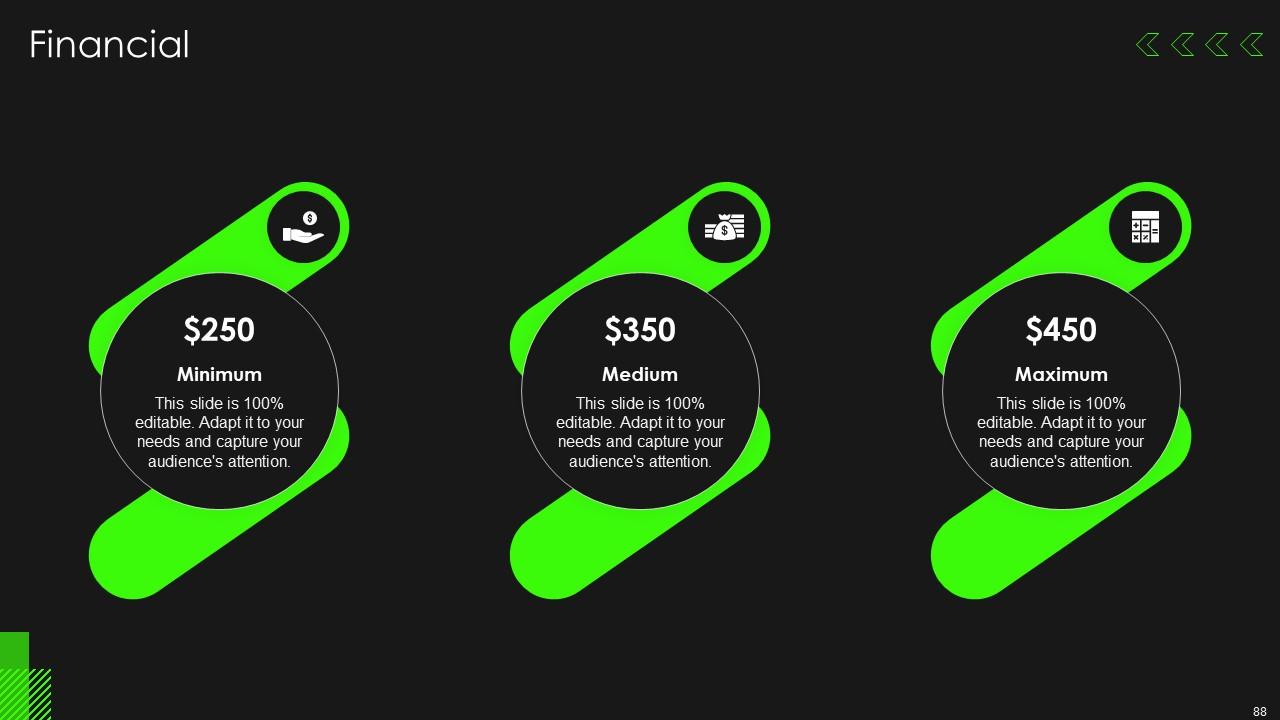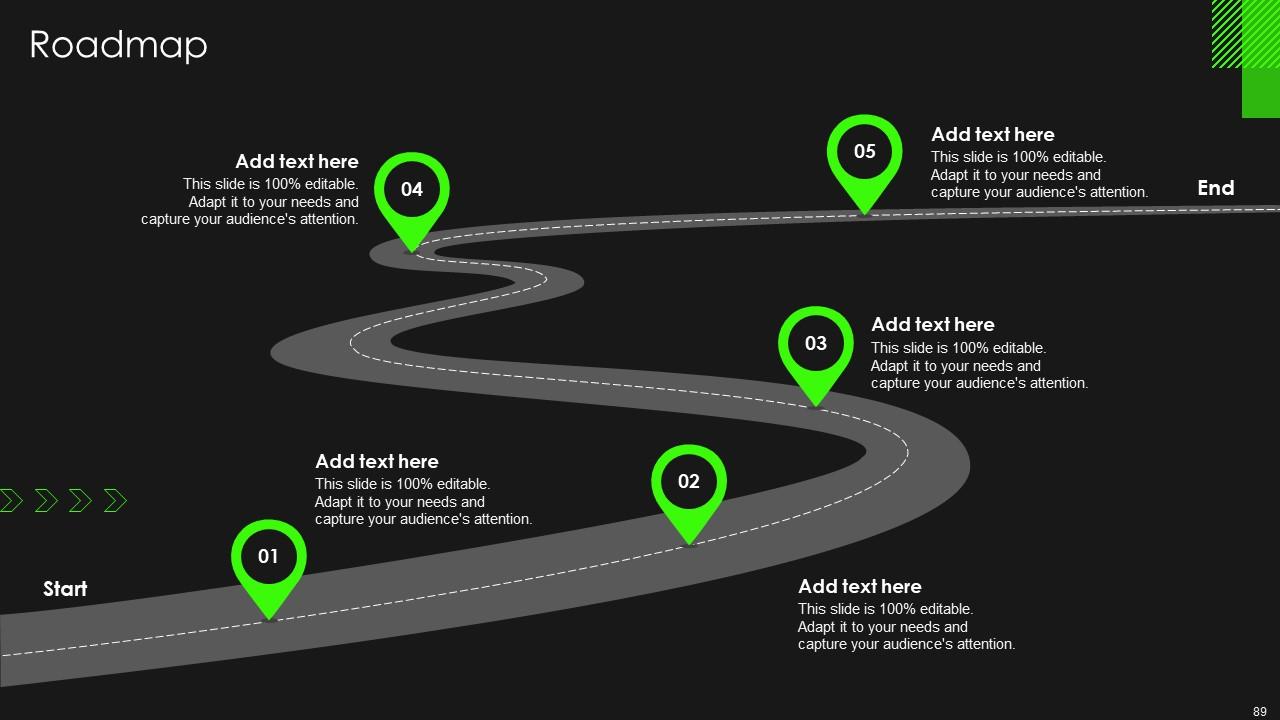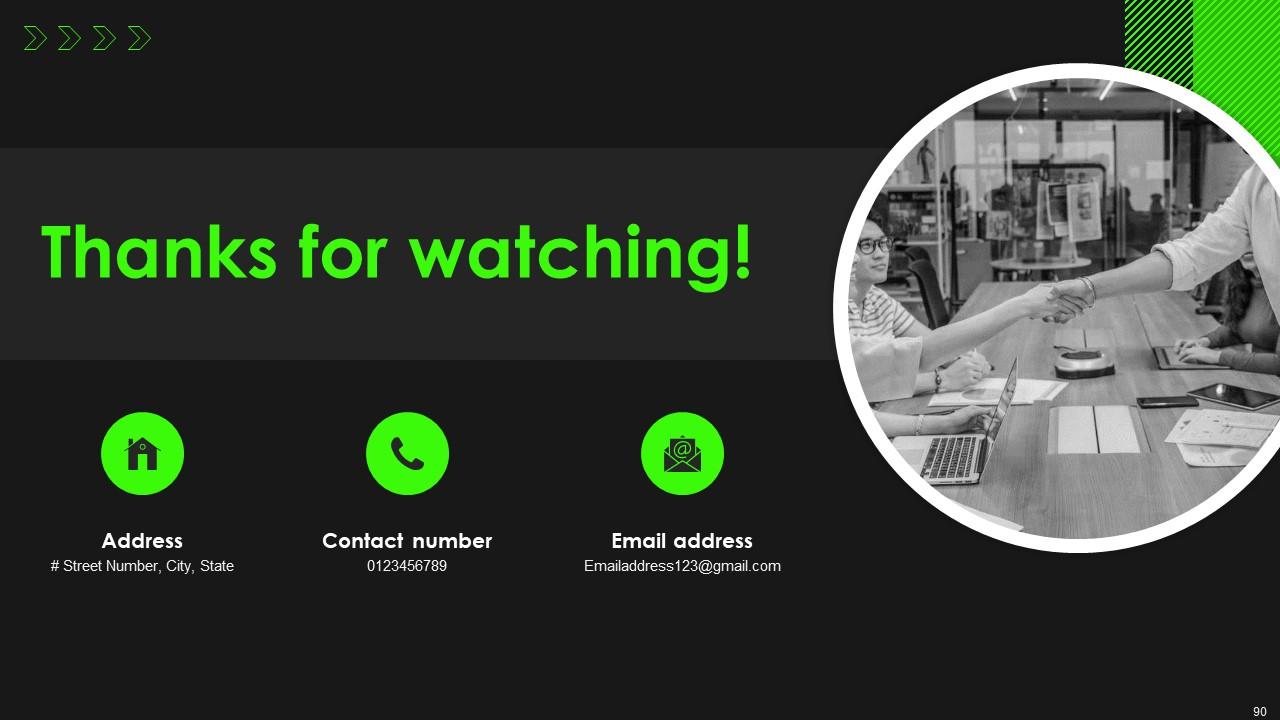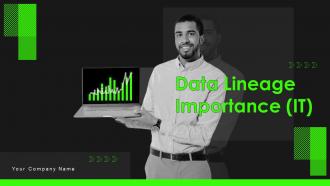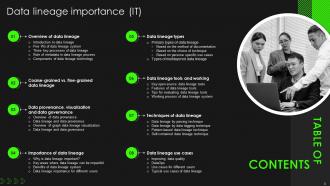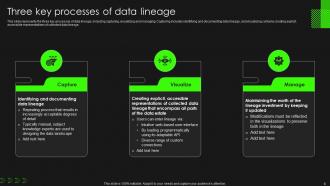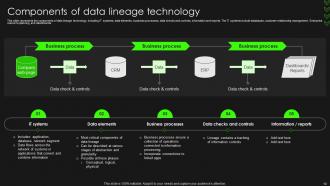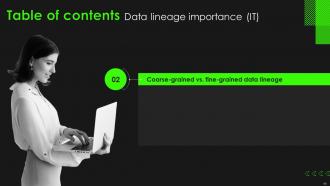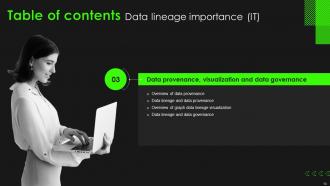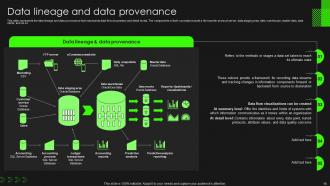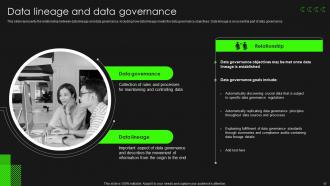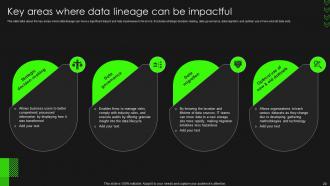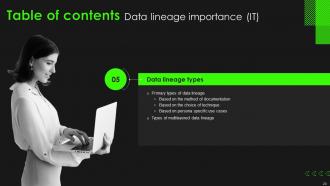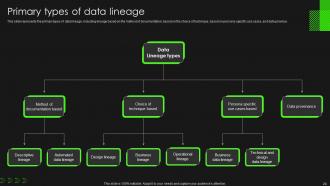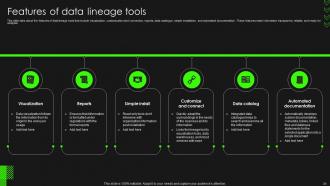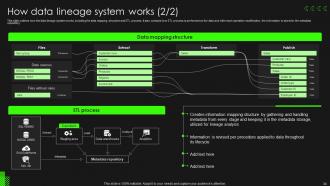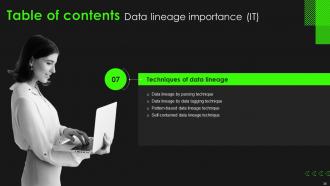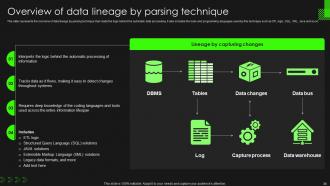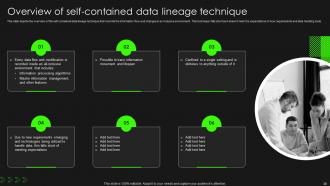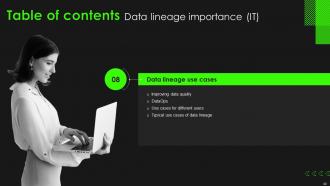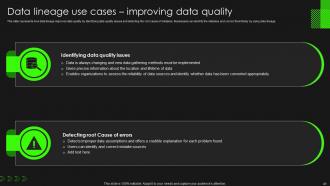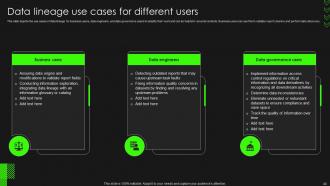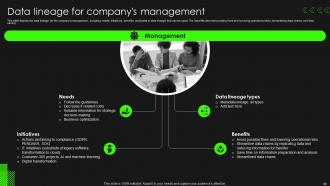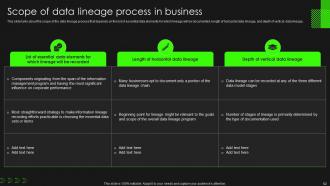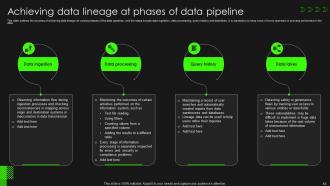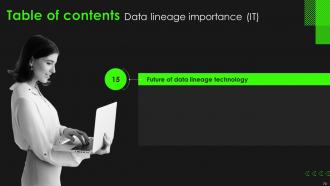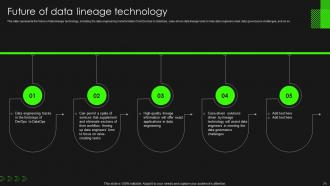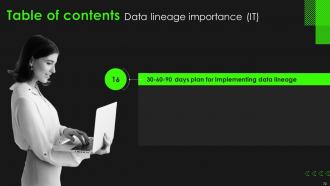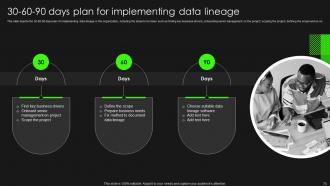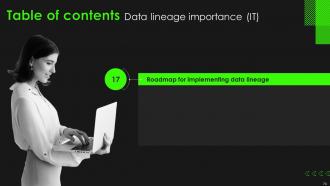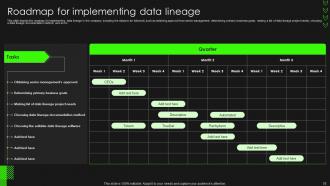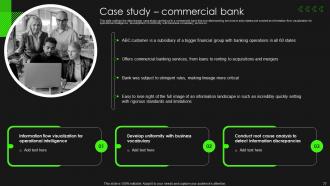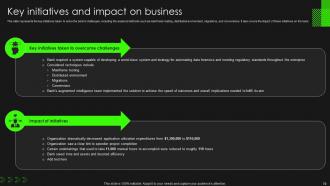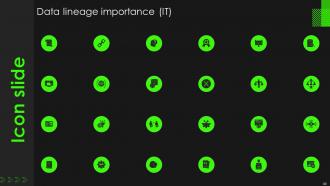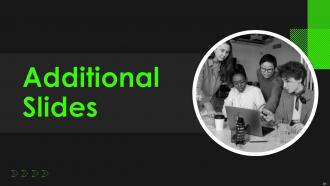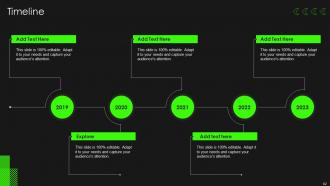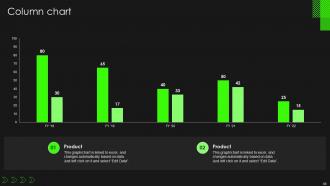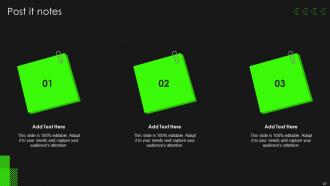Data Lineage Importance IT Powerpoint Presentation Slides
Explore our comprehensive PowerPoint presentation on Data Lineage Importance IT that provides a concise overview of data lineage, including its types, significance, techniques, and its relationship with data governance. This informative presentation covers essential aspects such as the introduction, the five Ws, key processes, the role of metadata, and components of data lineage technology. Additionally, the ETL Data Lineage PPT compares coarse-grained and fine-grained data lineage, data provenance, visualization, and data governance. It highlights the importance of data lineage by addressing its impact in key areas, benefits, and its relevance to different user groups. The presentation also delves into various types of data lineage based on documentation method, technique choices, persona-specific use cases, and multilayered data lineage. It provides insights into tools, working mechanisms, and different techniques of data lineage, including parsing, data tagging, pattern-based approaches, and self-contained methodologies. Furthermore, the Data Lineage Types template explores real-world use cases in different sectors, the scope of data lineage, implementation and training considerations, and the associated costs. The Data Lineage Techniques deck offers a glimpse into the future of data lineage technology, a 30-60-90 days plan, a roadmap, and presents a compelling case study related to a commercial bank. Download our 100 percent editable and customizable template now to leverage its potential for your organization. Compatible with Google Slides.
Explore our comprehensive PowerPoint presentation on Data Lineage Importance IT that provides a concise overview of data li..
- Google Slides is a new FREE Presentation software from Google.
- All our content is 100% compatible with Google Slides.
- Just download our designs, and upload them to Google Slides and they will work automatically.
- Amaze your audience with SlideTeam and Google Slides.
-
Want Changes to This PPT Slide? Check out our Presentation Design Services
- WideScreen Aspect ratio is becoming a very popular format. When you download this product, the downloaded ZIP will contain this product in both standard and widescreen format.
-

- Some older products that we have may only be in standard format, but they can easily be converted to widescreen.
- To do this, please open the SlideTeam product in Powerpoint, and go to
- Design ( On the top bar) -> Page Setup -> and select "On-screen Show (16:9)” in the drop down for "Slides Sized for".
- The slide or theme will change to widescreen, and all graphics will adjust automatically. You can similarly convert our content to any other desired screen aspect ratio.
Compatible With Google Slides

Get This In WideScreen
You must be logged in to download this presentation.
PowerPoint presentation slides
Deliver an informational PPT on various topics by using this Data Lineage Importance IT Powerpoint Presentation Slides. This deck focuses and implements best industry practices, thus providing a birds-eye view of the topic. Encompassed with ninety slides, designed using high-quality visuals and graphics, this deck is a complete package to use and download. All the slides offered in this deck are subjective to innumerable alterations, thus making you a pro at delivering and educating. You can modify the color of the graphics, background, or anything else as per your needs and requirements. It suits every business vertical because of its adaptable layout.
People who downloaded this PowerPoint presentation also viewed the following :
Content of this Powerpoint Presentation
Slide 1: This slide introduces Data Lineage Importance (IT). State your company name and begin.
Slide 2: This slide depicts the Agenda of the presentation.
Slide 3: This slide elucidates the Table of contents.
Slide 4: This is yet another slide continuing the Table of contents.
Slide 5: This slide exhibits the Title for the Topics to be covered further.
Slide 6: This slide represents the introduction to data lineage, including its overview.
Slide 7: This slide outlines the five ‘W’s of the data lineage system.
Slide 8: This slide reveals the three key processes of data lineage, including capturing, visualizing and managing.
Slide 9: This slide highlights the role of metadata in the data lineage process, including how it collects information about a particular report or ETL process throughout the organization.
Slide 10: This slide showcases the components of data lineage technology, such as IT systems, data elements, business processes, data checks and controls, information and reports.
Slide 11: This slide mentions the Heading for the Components to be discussed further.
Slide 12: This slide depicts the comparison between coarse-grained and fine-grained data lineage that involves the degree of data lineage a user can access.
Slide 13: This slide presents the Title for the Idaes to be covered next.
Slide 14: This slide displays the overview of data provenance, including the type of questions it answers.
Slide 15: This slide focuses on the data lineage and data provenance that represents data flow at summary and detail levels.
Slide 16: This slide gives an overview of graph data lineage visualization that enables business users to view and analyze data lineage to find solutions without technical skills.
Slide 17: This slide exhibits the relationship between data lineage and data governance, including how data lineage meets the data governance objectives.
Slide 18: This slide incorporates the Heading for the Topics to be covered in the upcoming template.
Slide 19: This slide states the importance of data lineage.
Slide 20: This slide talks about the key areas where data lineage can have a significant impact and help businesses to fix errors.
Slide 21: This slide shows the Benefits of data lineage system.
Slide 22: This slide depicts the importance of data lineage for different users such as ETL (Extract, Transform, and Load) developers, data stewards, business users, and troubleshooting operators.
Slide 23: This slide highlights the Title for the Components to be covered in the forth-coming template.
Slide 24: This slide represents the primary types of data lineage, including lineage based on the method of documentation, based on the choice of technique, based on persona-specific use cases, and data province.
Slide 25: This slide describes the type of data lineage based on the method of documentation such as descriptive and automated data lineage.
Slide 26: This slide talks about the types of data lineage based on the choice of technique, including design, business, and operational lineage.
Slide 27: This slide describes the type of data lineage based on persona-specific use cases and includes business, technical and design data lineage.
Slide 28: This slide outlines the multi-layered data lineage type, including cross-system, end-to-end column, and inner-system data lineage.
Slide 29: This slide displays the Title for the Topics to be discussed further.
Slide 30: This slide represents the essential open-source data lineage tools to trace data modifications at each step and get the most value from the information.
Slide 31: This slide talks about the features of data lineage tools that include visualization, customization and connection, reports, data catalogue, simple installation, and automated documentation.
Slide 32: This slide showcases the criteria tips for evaluating data lineage tools, including data sources, data lineage requirements, visualization features, and ease of implementation.
Slide 33: This slide focuses on the working process of the data lineage system, from metadata to final reports or dashboards for non-technical end users.
Slide 34: This is yet another slide continuing the working process of the data lineage system.
Slide 35: This slide elucidates the Heading for the Topics to be discussed in the upcoming template.
Slide 36: This slide outlines the overview of data lineage by parsing technique that reads the logic behind the automatic data processing.
Slide 37: This slide talks about the lineage by data tagging technique that represents data lineage by tracking the information tag provided by the transformation engine.
Slide 38: This slide mentions the pattern-based data lineage technique that generates the data lineage using patterns in metadata.
Slide 39: This slide depicts the overview of the self-contained data lineage technique that records the information flow and changes in an inclusive environment.
Slide 40: This slide covers the Title for the Ideas to be further discussed.
Slide 41: This slide represents how data lineage improves data quality by identifying data quality issues and detecting the root cause of mistakes.
Slide 42: This slide talks about how data lineage simplifies the data operations (DataOps), including impacting analysis, system upgrades, and data migrations.
Slide 43: This slide depicts the use cases of data lineage for business users, data engineers, and data governance users to simplify their work and can be helpful in several contexts.
Slide 44: This slide outlines the typical use cases of data lineage that include performing root-cause analysis, generating reports, deprecating columns, and setting data retention policies.
Slide 45: This slide showcases the Heading for the Ideas to be covered in the forth-coming template.
Slide 46: This slide displays the data lineage for the company’s management, including needs, initiatives, benefits, and types of data lineage that can be used.
Slide 47: This slide focuses on the data lineage for business people, including their needs, initiatives, benefits and type of lineages that can be used.
Slide 48: This slide showcases the importance of data lineage for data management professionals and caters to their needs, initiatives, benefits, and type of lineage.
Slide 49: This slide covers the importance of data lineage for technical experts, containing their requirements, projects, benefits, and type of data lineage.
Slide 50: This slide highlights the Heading for the Ideas to be discussed further.
Slide 51: This slide represents the horizontal, vertical and physical lineage that defines the scope of data lineage.
Slide 52: This slide deals with the scope of the data lineage process in business.
Slide 53: This slide depicts the descriptive and automated data lineage methods of documentation, including how the descriptive data lineage method works on the conceptual and logical levels.
Slide 54: This slide shows how businesses can employ data lineage throughout their organizations, including automatically tracking information flow from source to destination, time-saving for IT teams, and transparency into information connections.
Slide 55: This slide reveals the Title for the Ideas to be covered next.
Slide 56: This slide represents the real-world applications of data lineage in different industries.
Slide 57: This slide elucidates the Heading for the Ideas to be discussed in the following template.
Slide 58: This slide describes the best practices of data lineage, and it includes automated data lineage generation, tracing multiple types of lineage, putting data lineage to work, and tracking data lineage comprehensively.
Slide 59: This slide shows the reference architecture for building passive data lineage system in an organization, including three logical components.
Slide 60: This slide illustrates the Management workflow of data lineage system.
Slide 61: This slide states the steps to implement data lineage in business.
Slide 62: This is yet another slide continuing the steps to implement data lineage.
Slide 63: This slide outlines the process of achieving data lineage at various phases of the data pipelines, and the steps include data ingestion, data processing, query history and data lakes.
Slide 64: This slide represents the extraction process for data lineage from start to end.
Slide 65: This slide shows the Title for the Components to be covered next.
Slide 66: This slide illustrates the data lineage training program for employees, including the modules to be covered in the training, trainer name, participant teams, training schedule, and venue.
Slide 67: This slide describes the implementation cost of data lineage, including the cost of data lineage tools cost, required hardware and software costs, data lineage training costs, and other expenditures.
Slide 68: This slide mentions the Title for the Topics to be discussed further.
Slide 69: This slide showcases the visualization data lineage of Spark jobs.
Slide 70: This slide focuses on the Heading for the Componenets to be covered in the upcoming template.
Slide 71: This slide represents the future of data lineage technology.
Slide 72: This slide exhibits the Title for the Ideas to be covered further.
Slide 73: This slide depicts the 30-60-90 days plan for implementing data lineage in the organization.
Slide 74: This slide displays the Heading for the Topics to be discussed next.
Slide 75: This slide showcases the roadmap for implementing data lineage in the company.
Slide 76: This slide elucidates the Heading for the Components to be further discussed.
Slide 77: This slide outlines the data lineage case study carried out in a commercial bank that provides banking services in sixty states.
Slide 78: This slide describes the client organization's challenges and objectives.
Slide 79: This slide represents the key initiatives taken to solve the bank's challenges, including the explored methods such as mainframe testing, distributed environment, migrations, and conversions.
Slide 80: This slide contains all the icons used in this presentation.
Slide 81: This slide is titled as Additional Slides for moving forward.
Slide 82: This is a Timeline slide. Show data related to time intervals here.
Slide 83: This slide contains Puzzle with related icons and text.
Slide 84: This slide depicts Venn diagram with text boxes.
Slide 85: This is Our Target slide. State your targets here.
Slide 86: This slide displays Column chart with two products comparison.
Slide 87: This slide shows Post It Notes. Post your important notes here.
Slide 88: This is a Financial slide. Show your finance related stuff here.
Slide 89: This slide presents Roadmap with additional textboxes.
Slide 90: This is a Thank You slide with address, contact numbers and email address.
Data Lineage Importance IT Powerpoint Presentation Slides with all 95 slides:
Use our Data Lineage Importance IT Powerpoint Presentation Slides to effectively help you save your valuable time. They are readymade to fit into any presentation structure.
FAQs
Data lineage visualization, such as graph-based representations, empowers business users to understand and analyze data lineage without requiring technical expertise. It facilitates problem-solving and decision-making processes.
Data lineage supports data governance objectives by providing transparency and traceability of data flows. It helps ensure compliance, data quality, and accountability within an organization.
Data lineage is crucial for organizations as it enhances data understanding, promotes data quality, facilitates compliance efforts, aids in troubleshooting and debugging, and supports decision-making processes.
Various user roles can benefit from data lineage, including ETL developers, data stewards, business users, troubleshooting operators, data governance teams, and technical experts involved in data management and analysis.
Data lineage can have a significant impact on areas such as error identification and resolution, data quality improvement, system upgrades, data migrations, compliance audits, and root-cause analysis.
-
I was never satisfied with my own presentation design but SlideTeam has solved that problem for me. Thank you SlideTeam!
-
“I required a slide for a board meeting and was so satisfied with the final result !! So much went into designing the slide and the communication was amazing! Can’t wait to have my next slide!”



